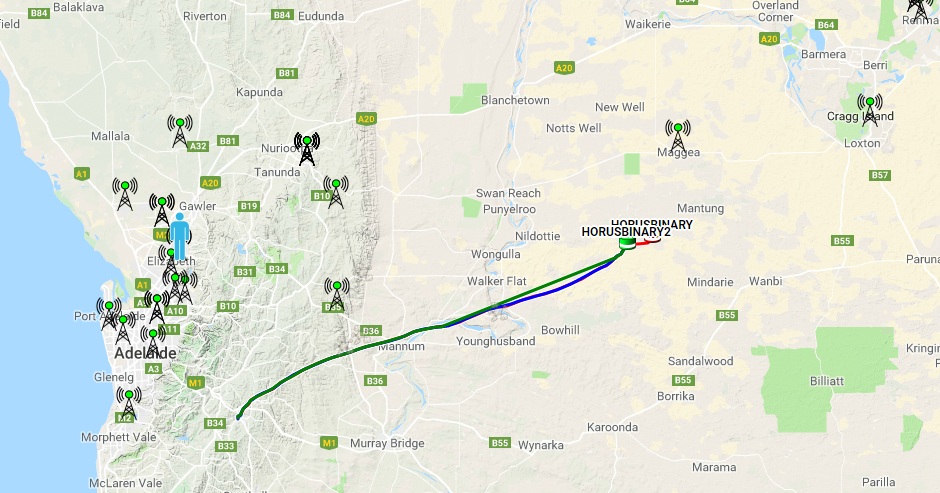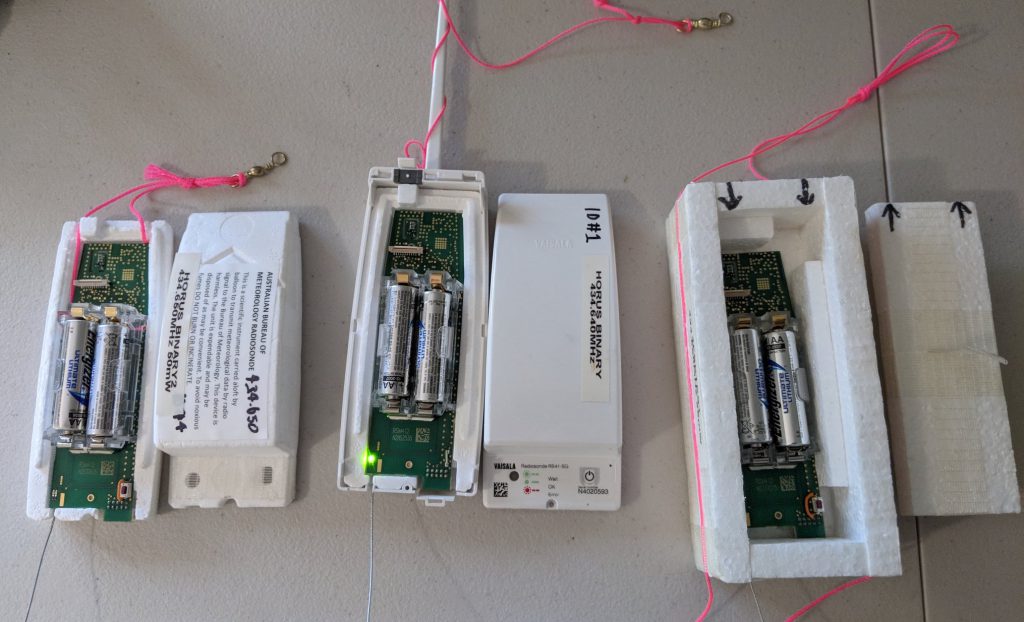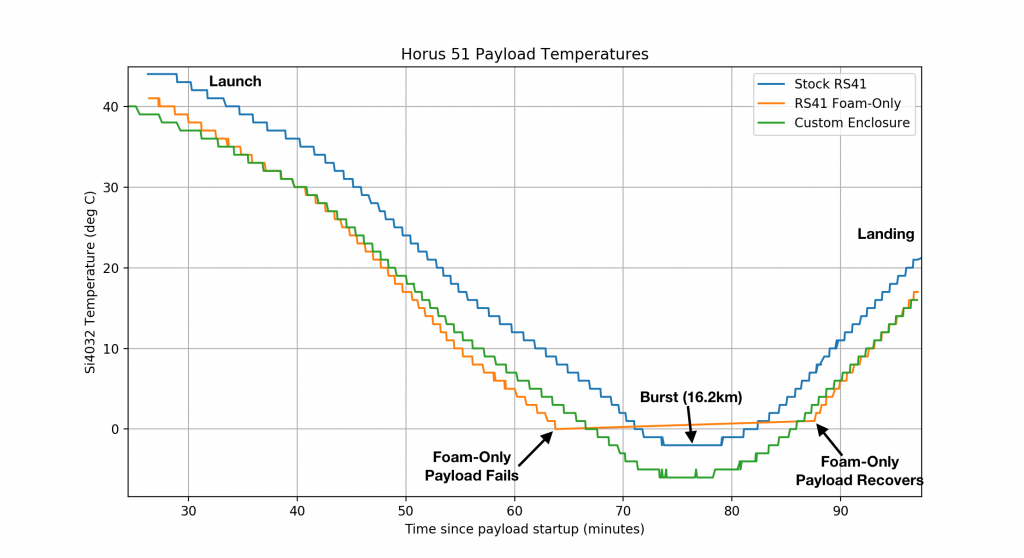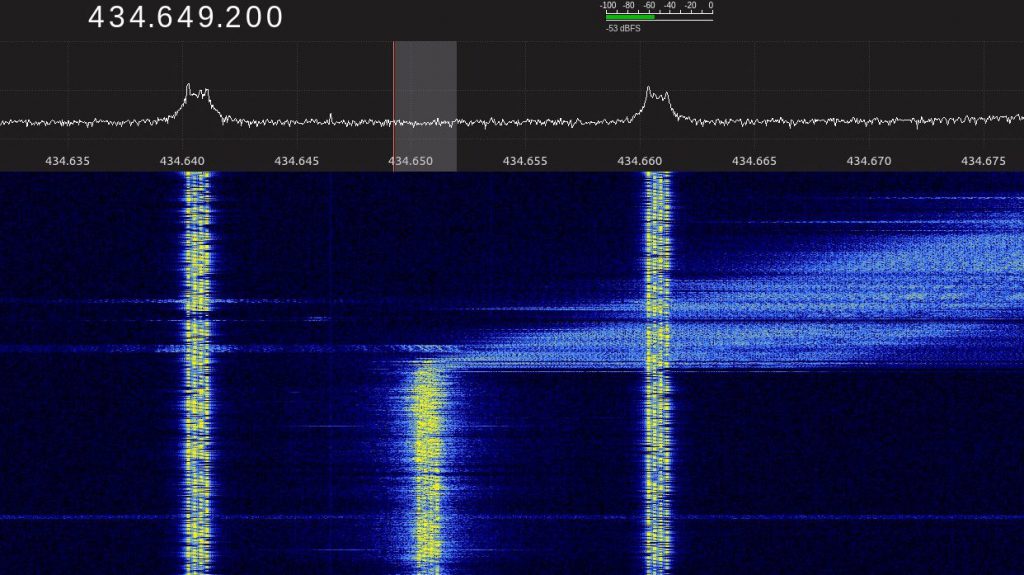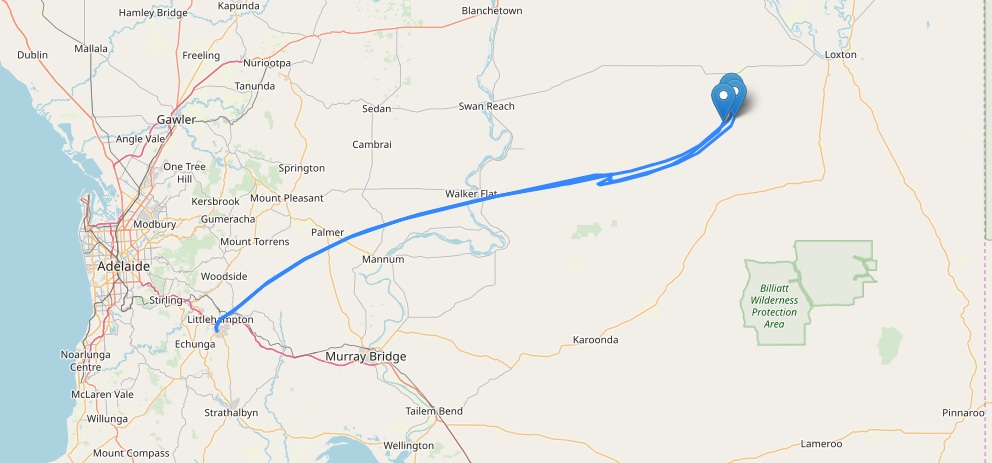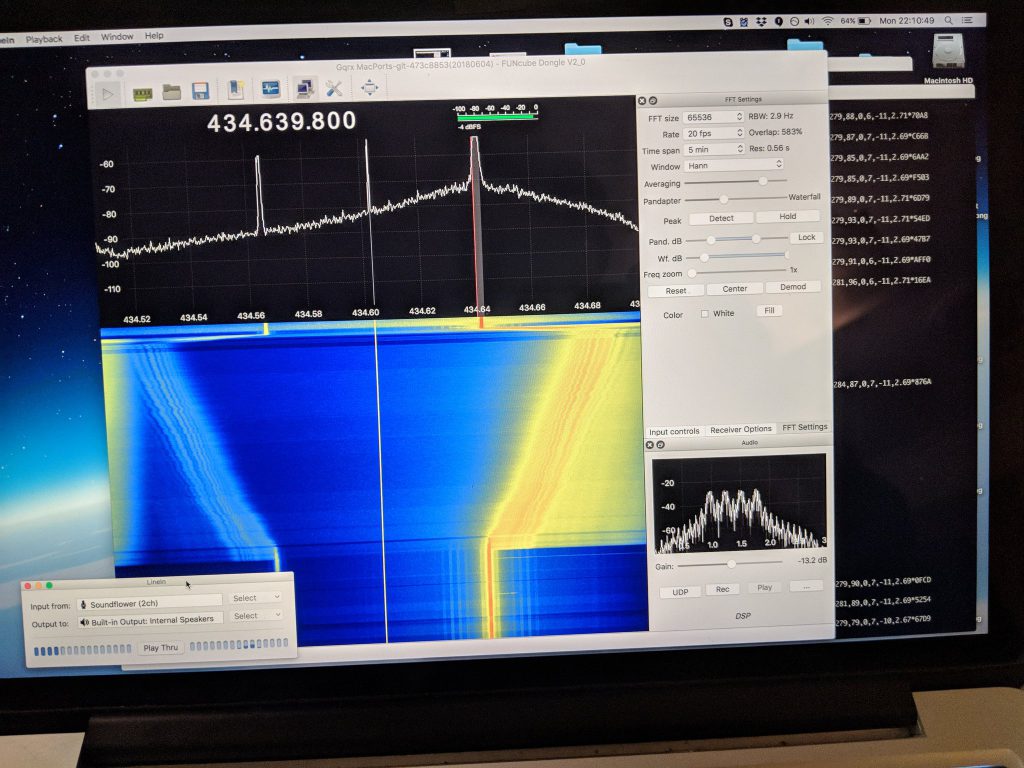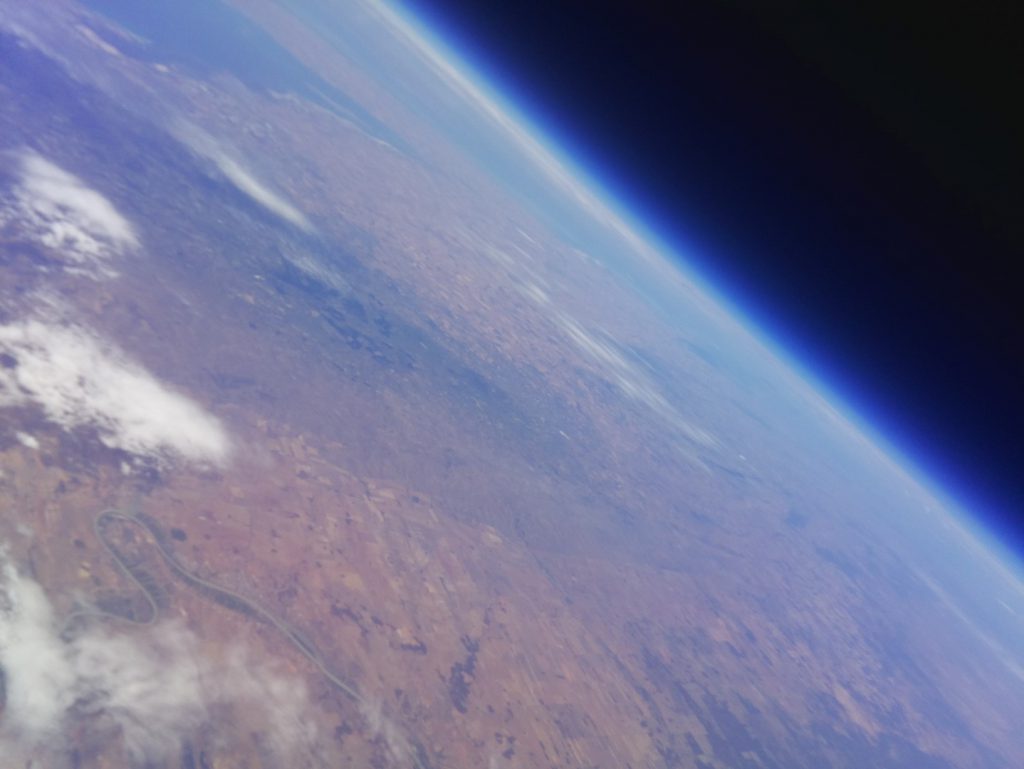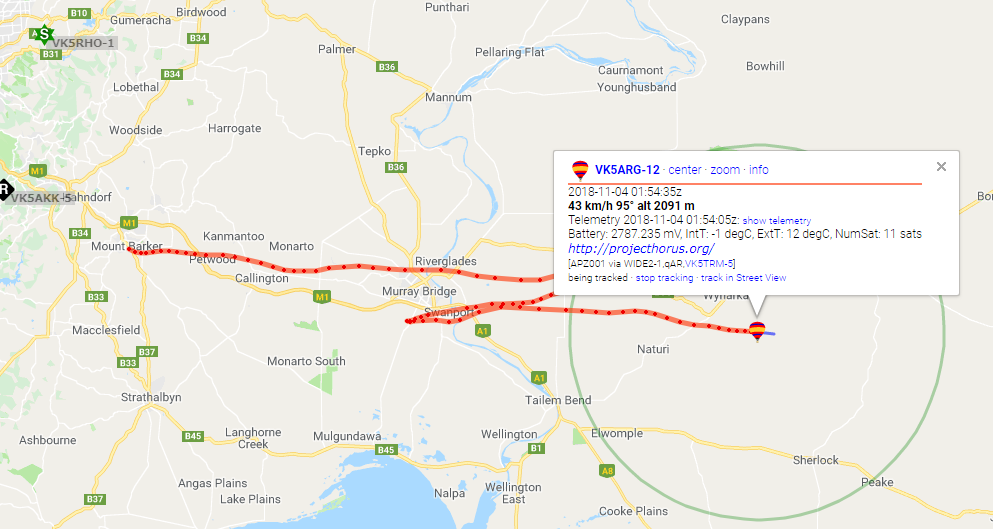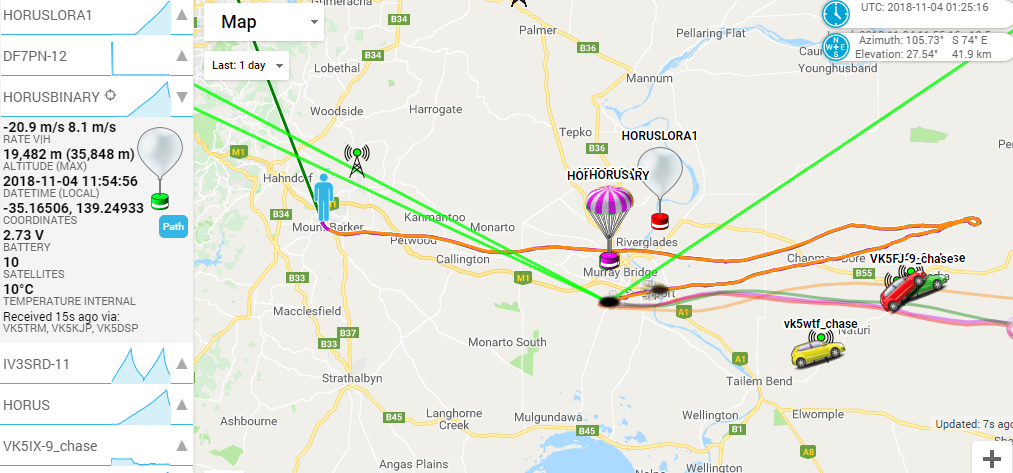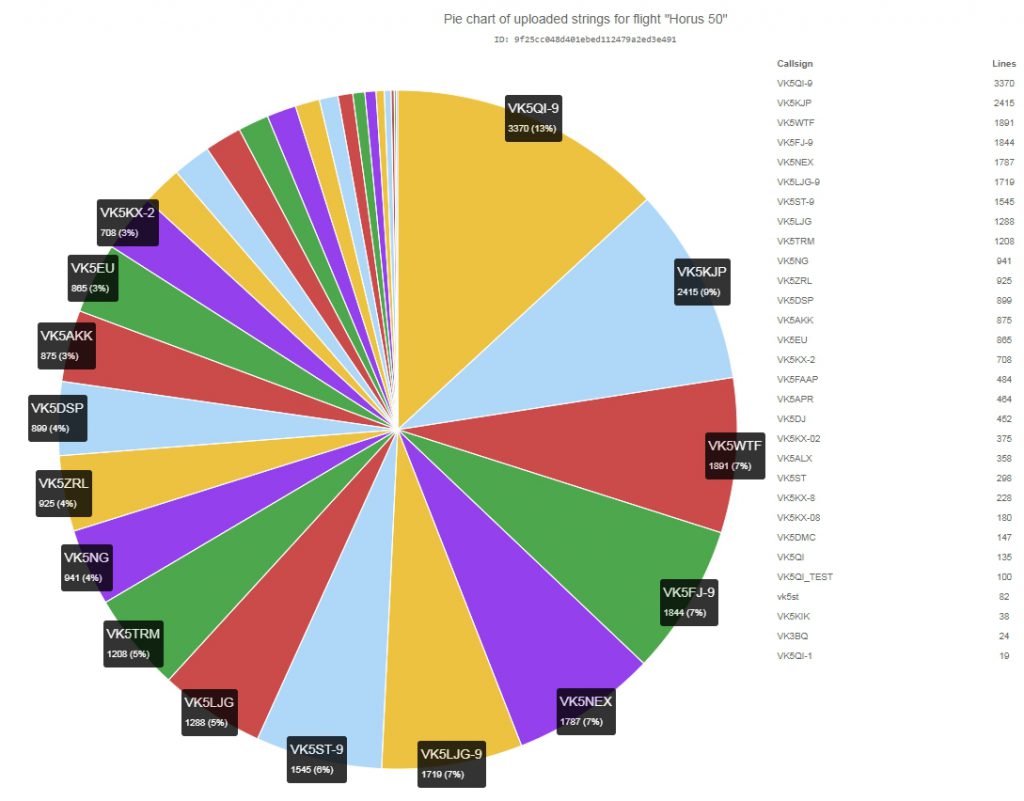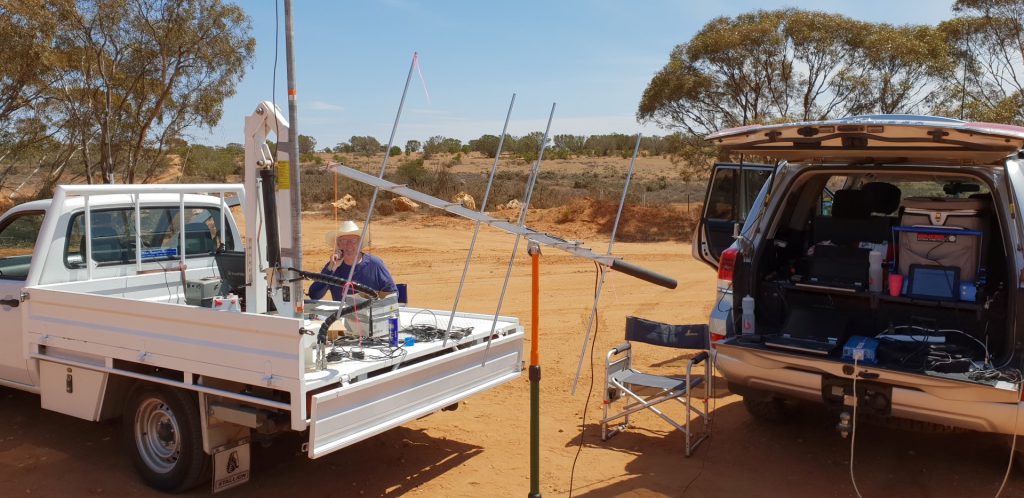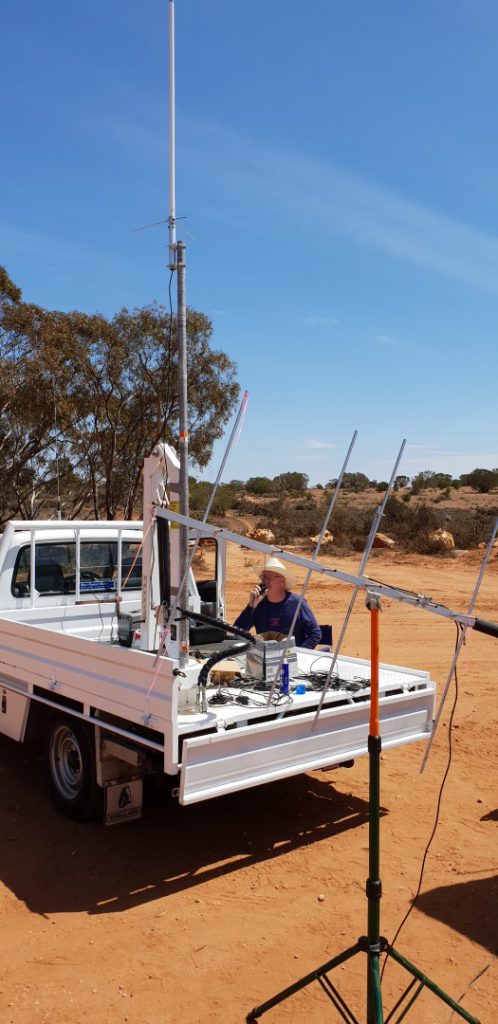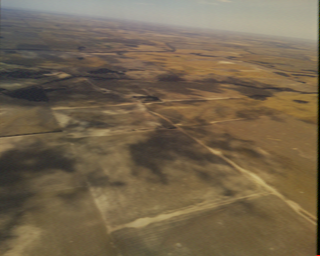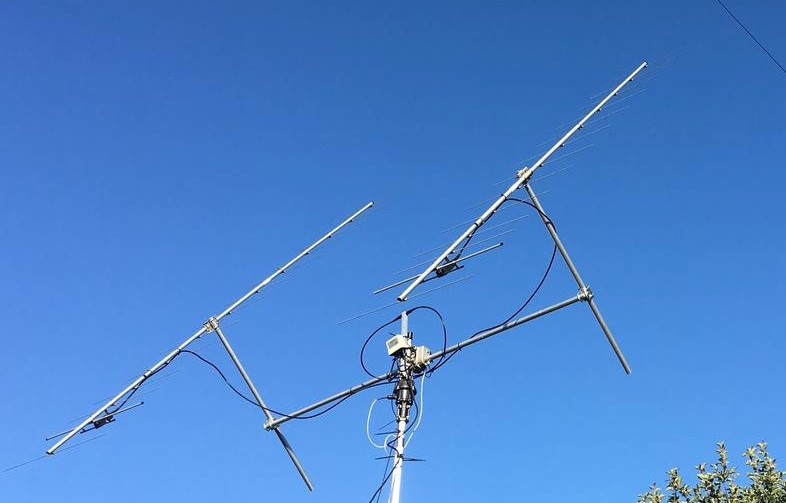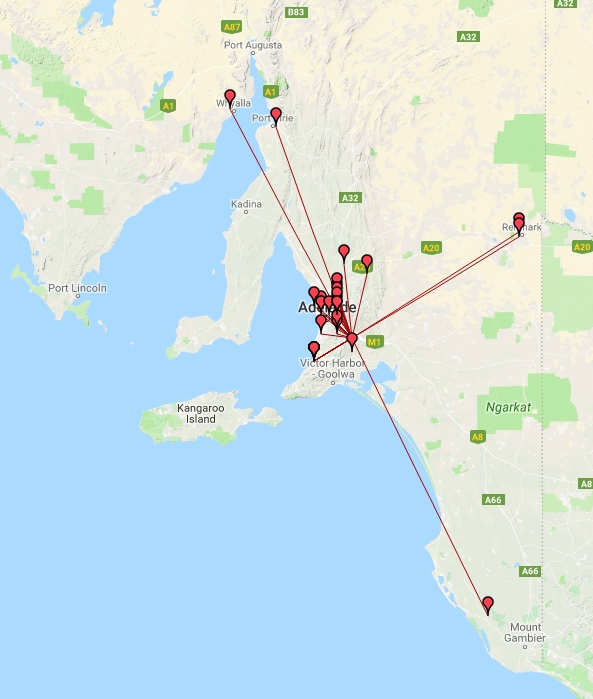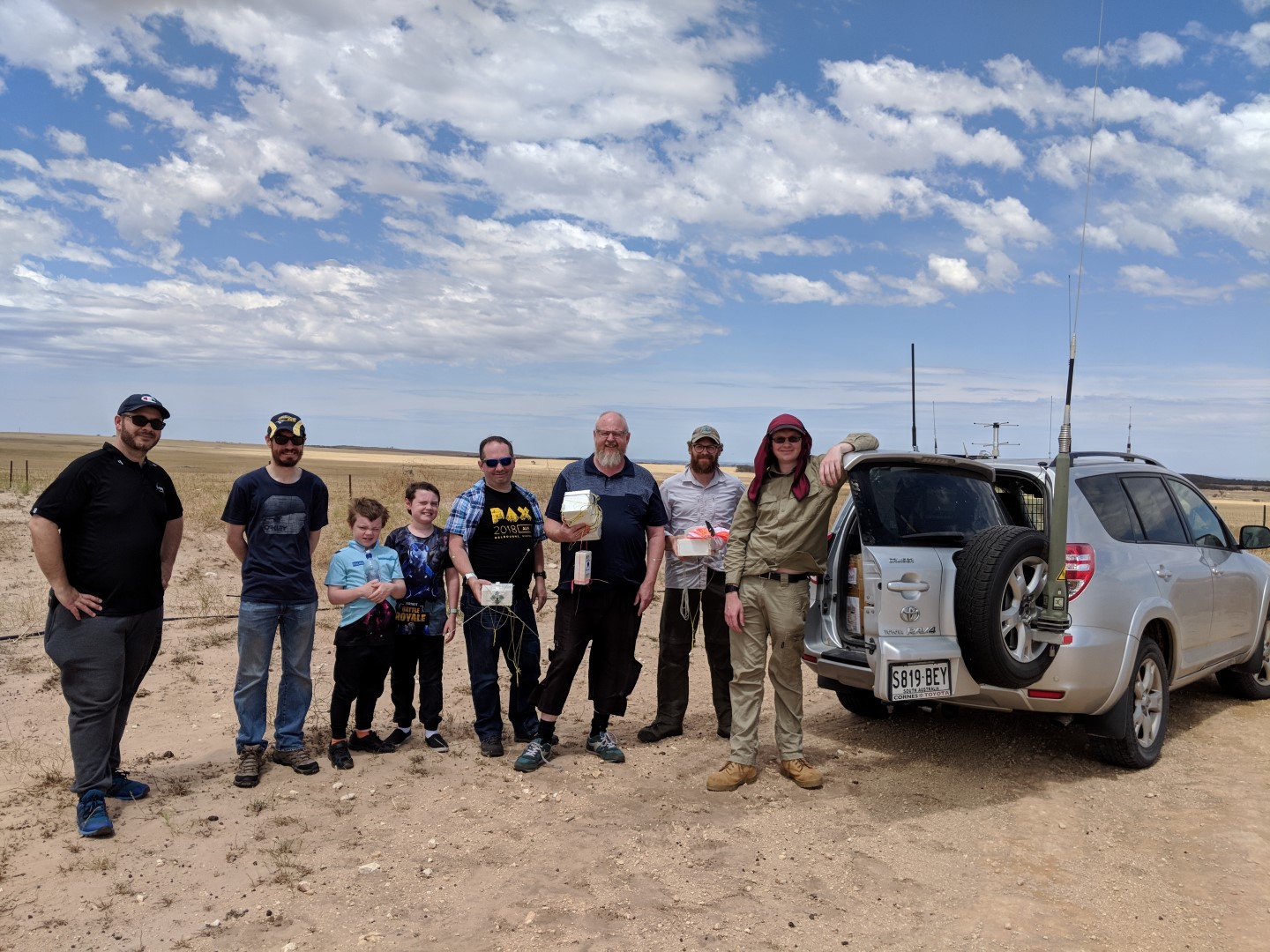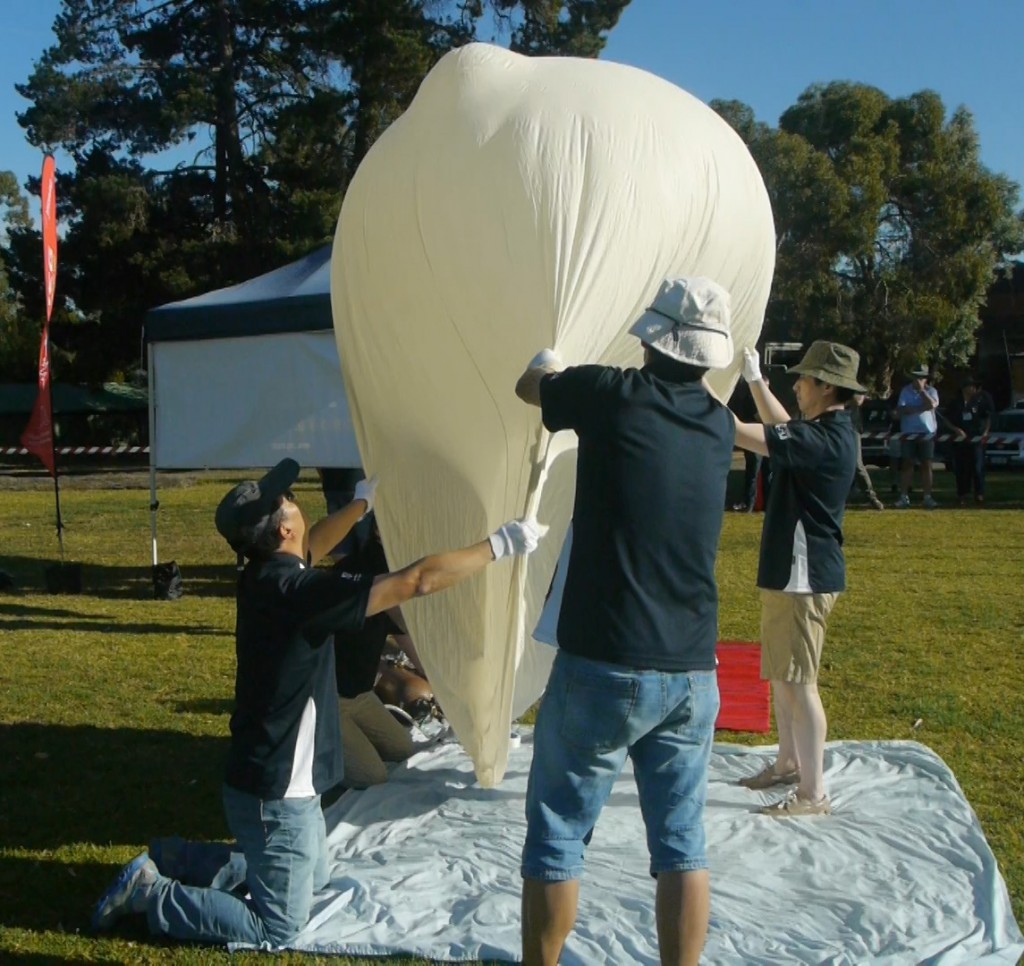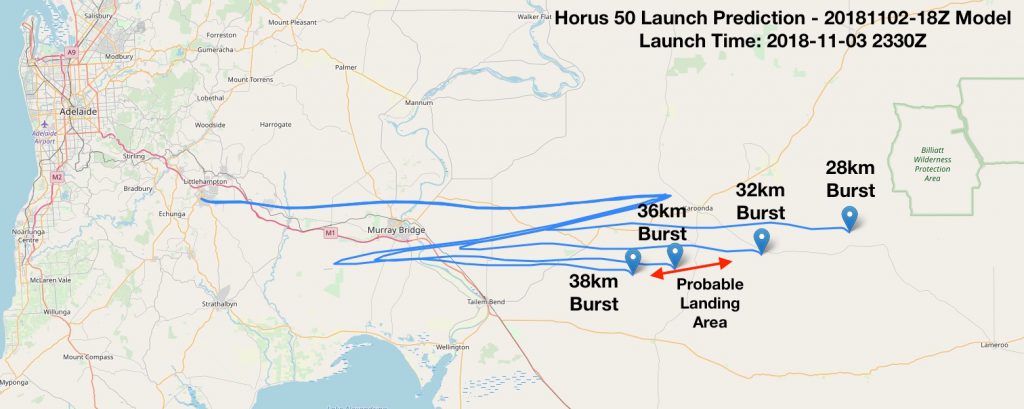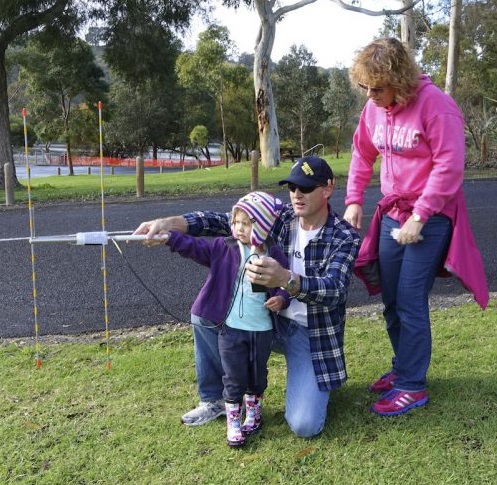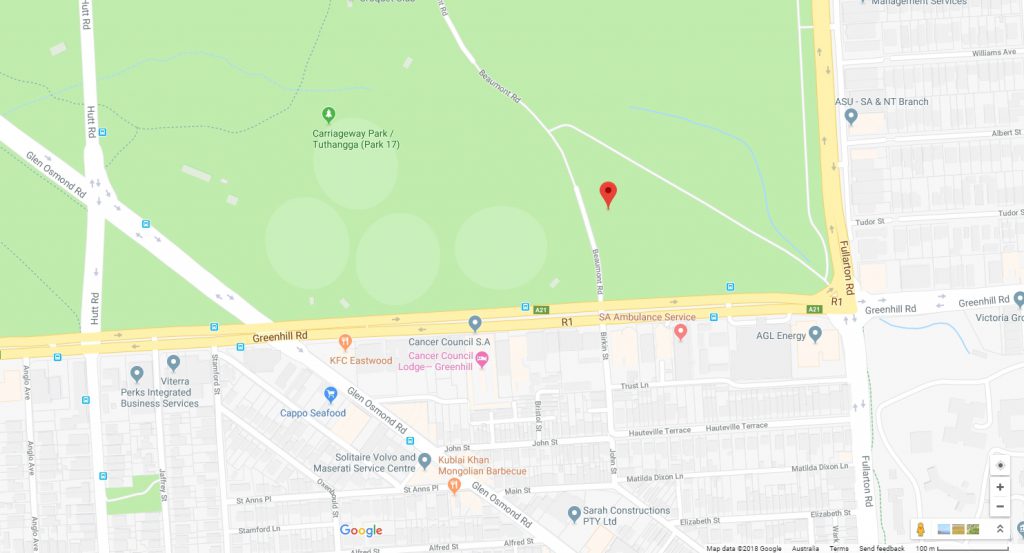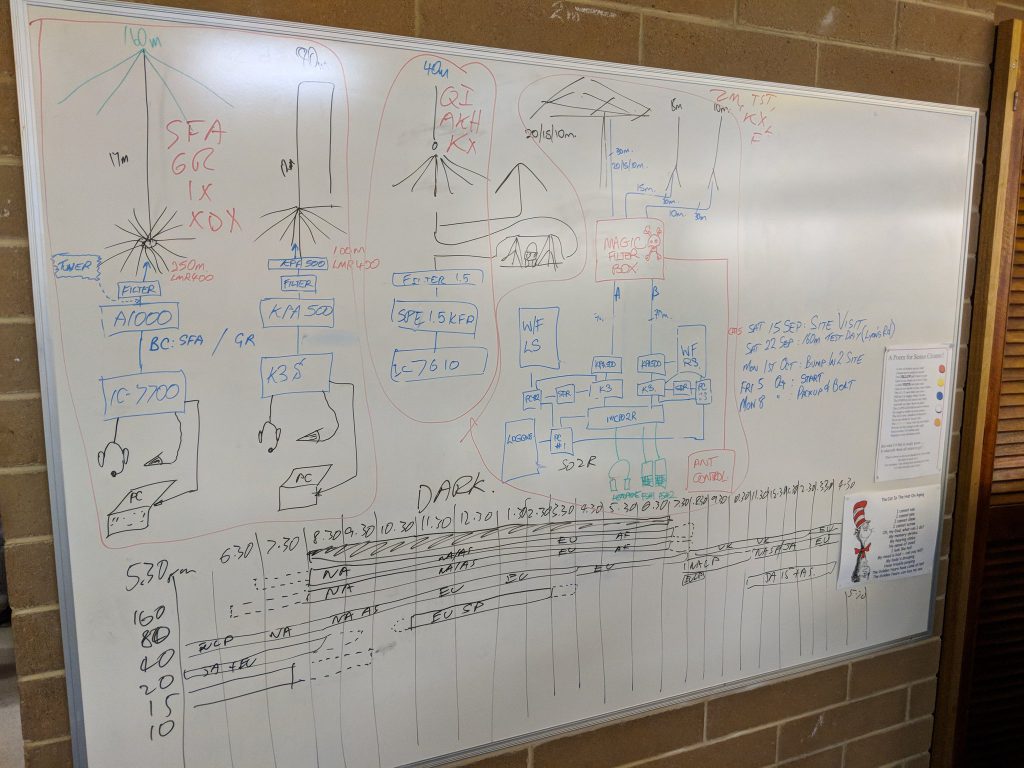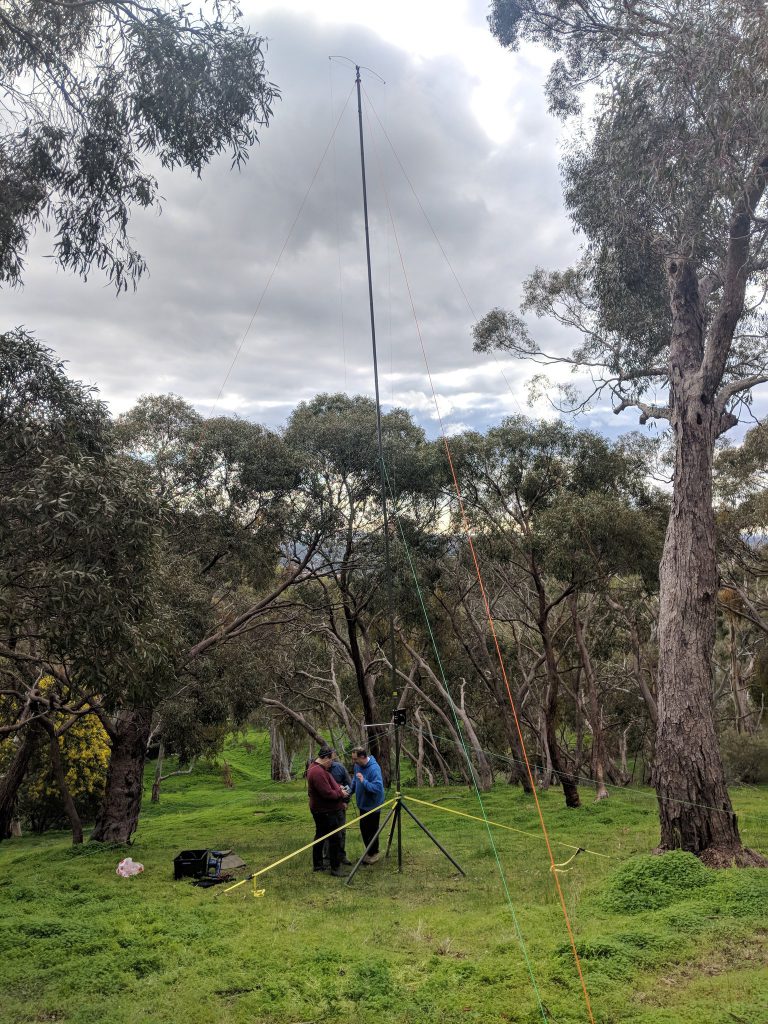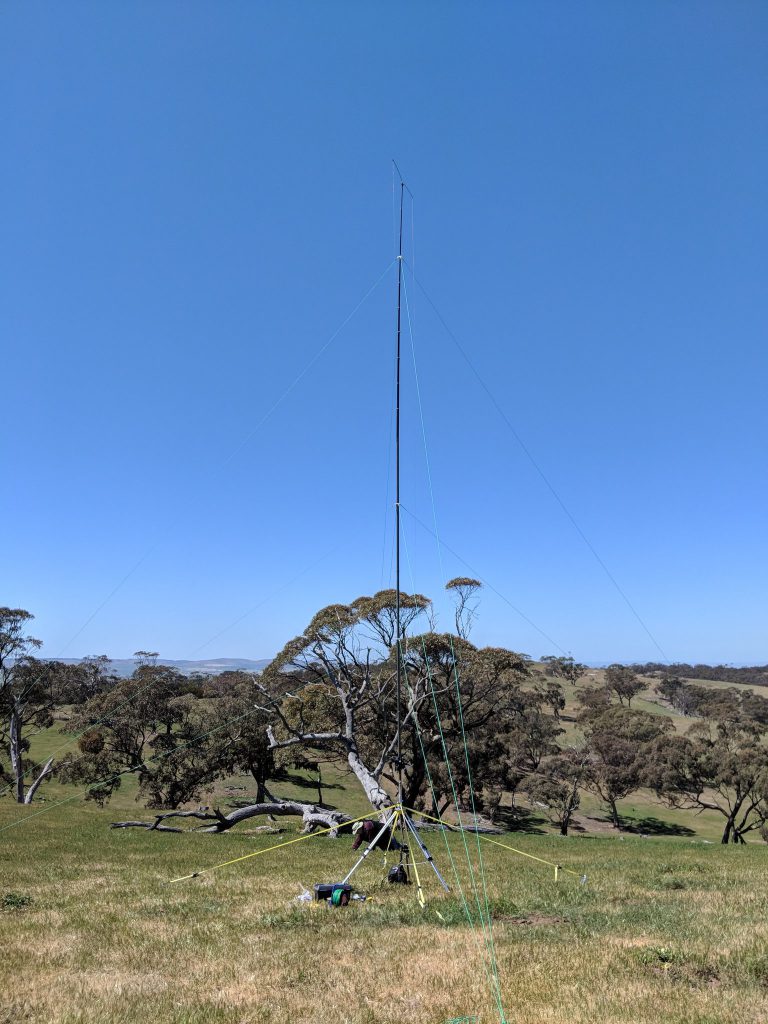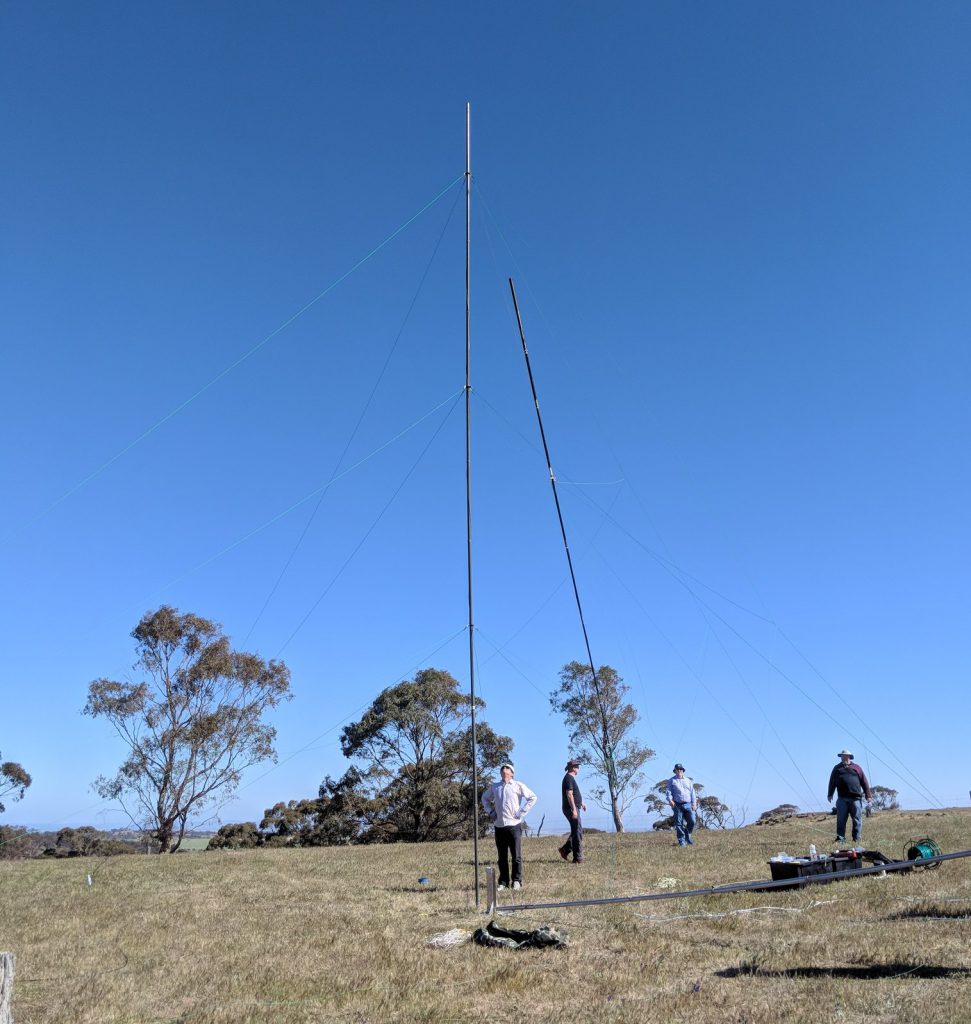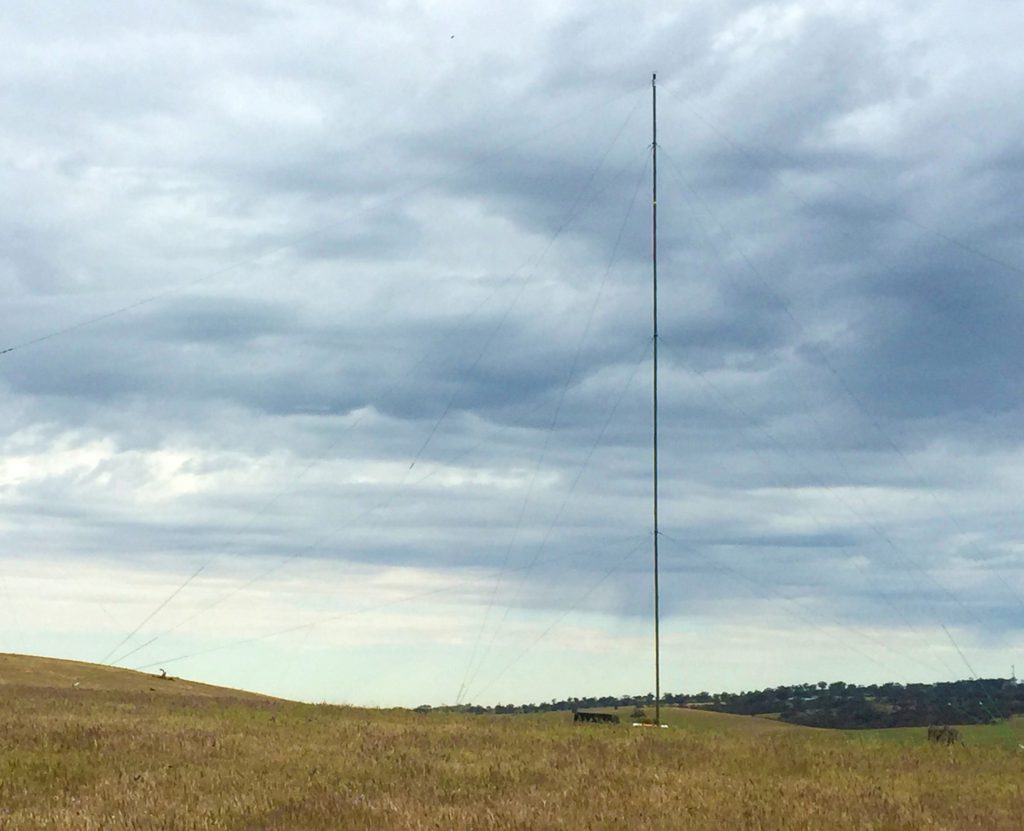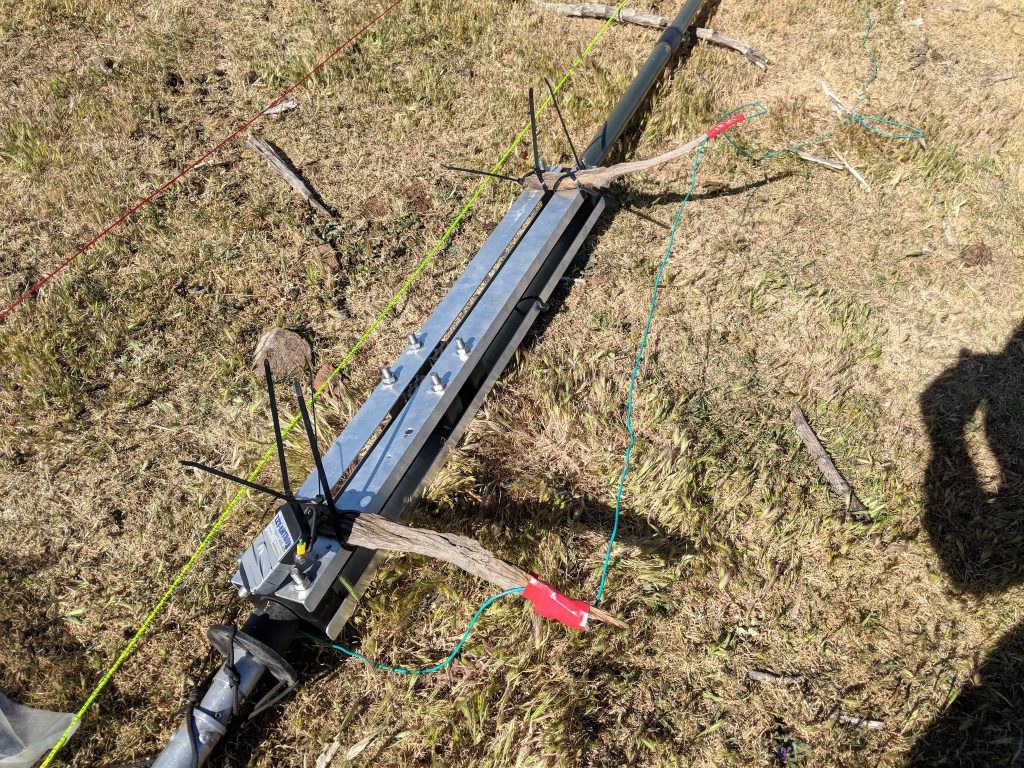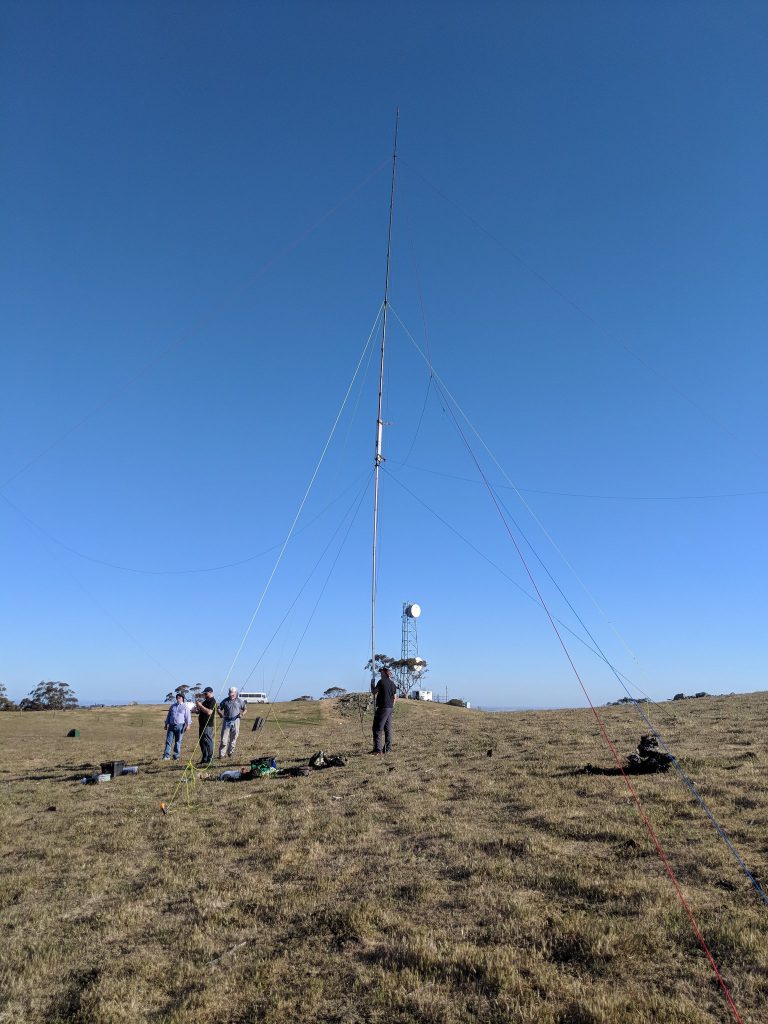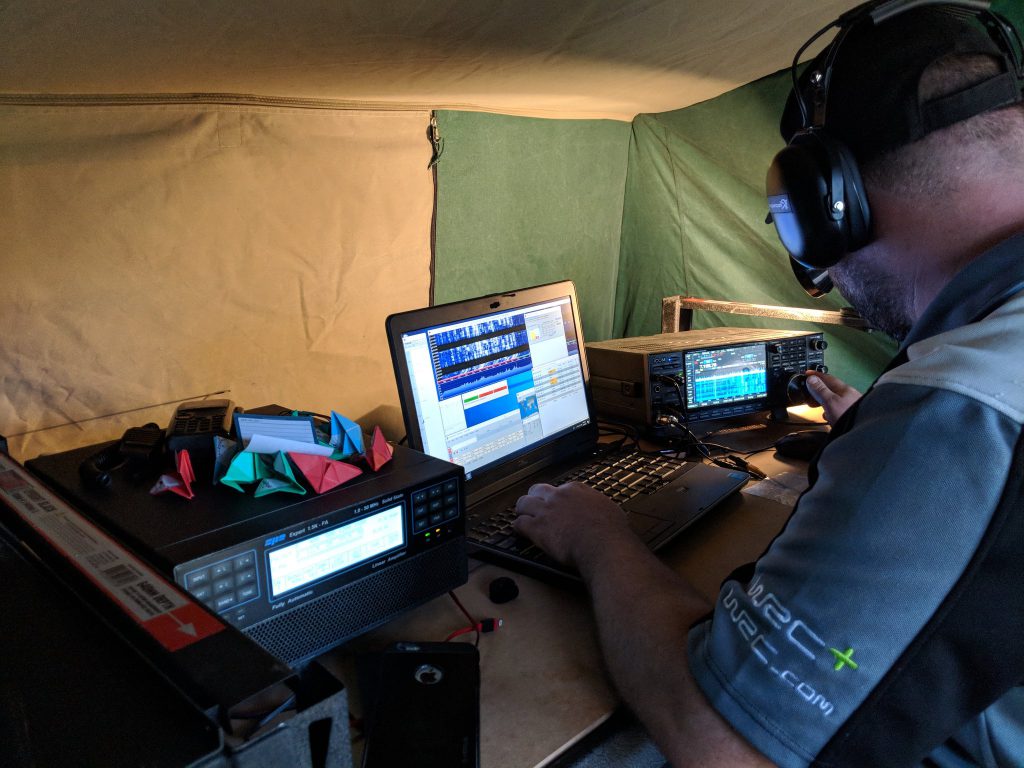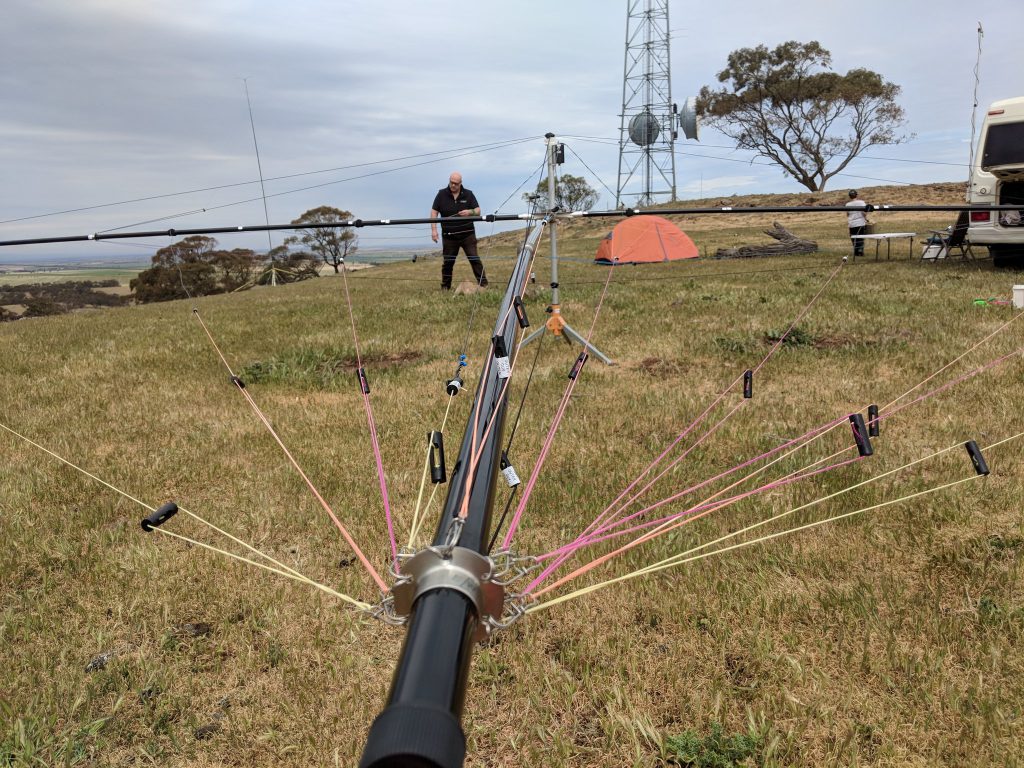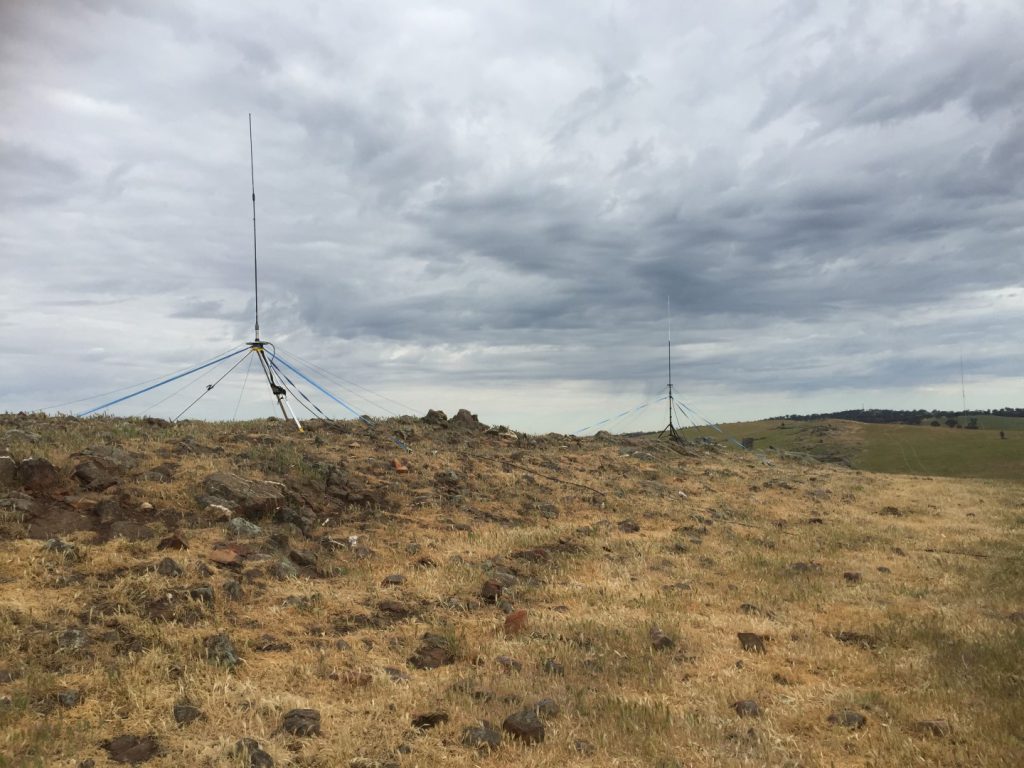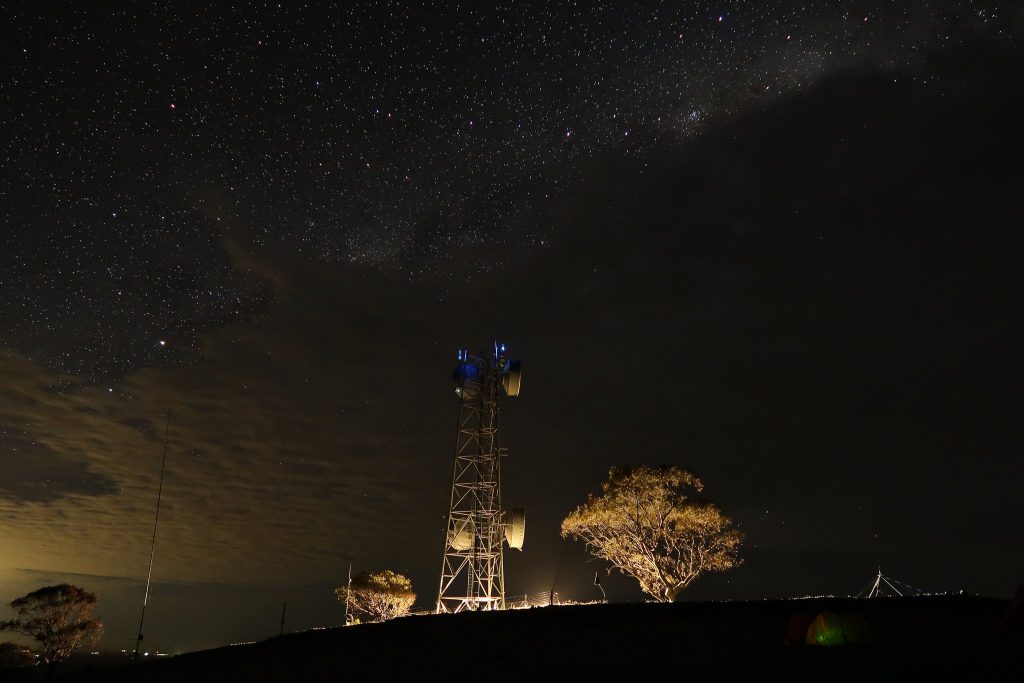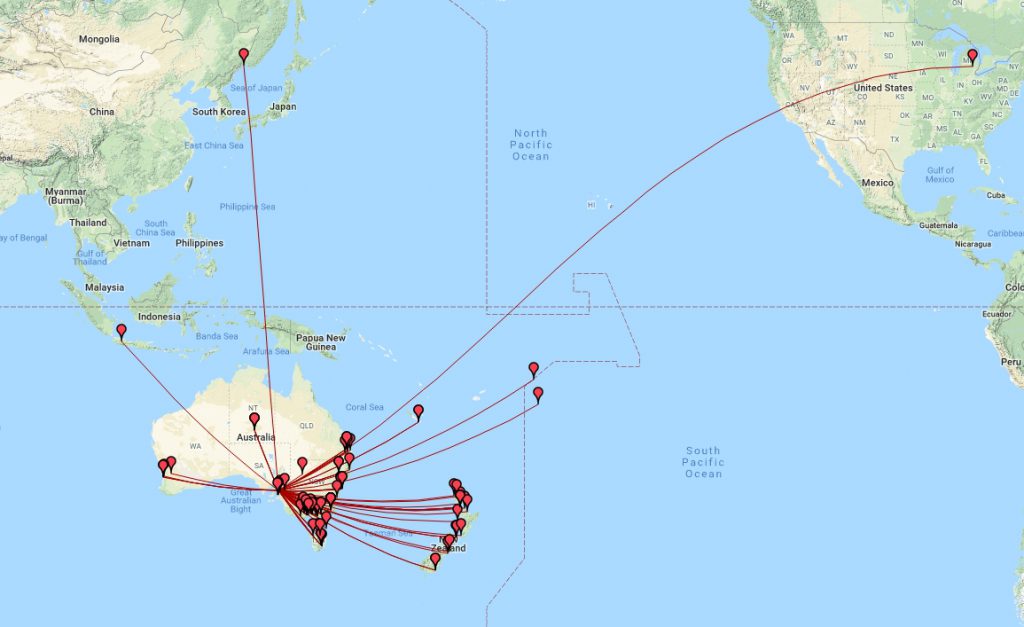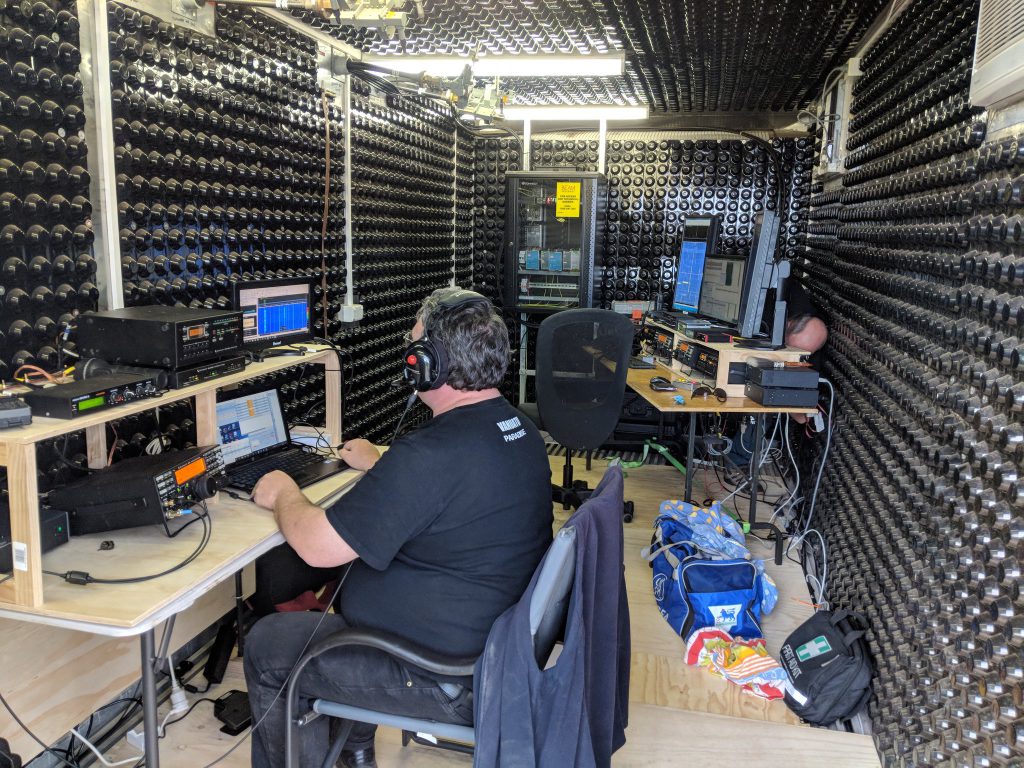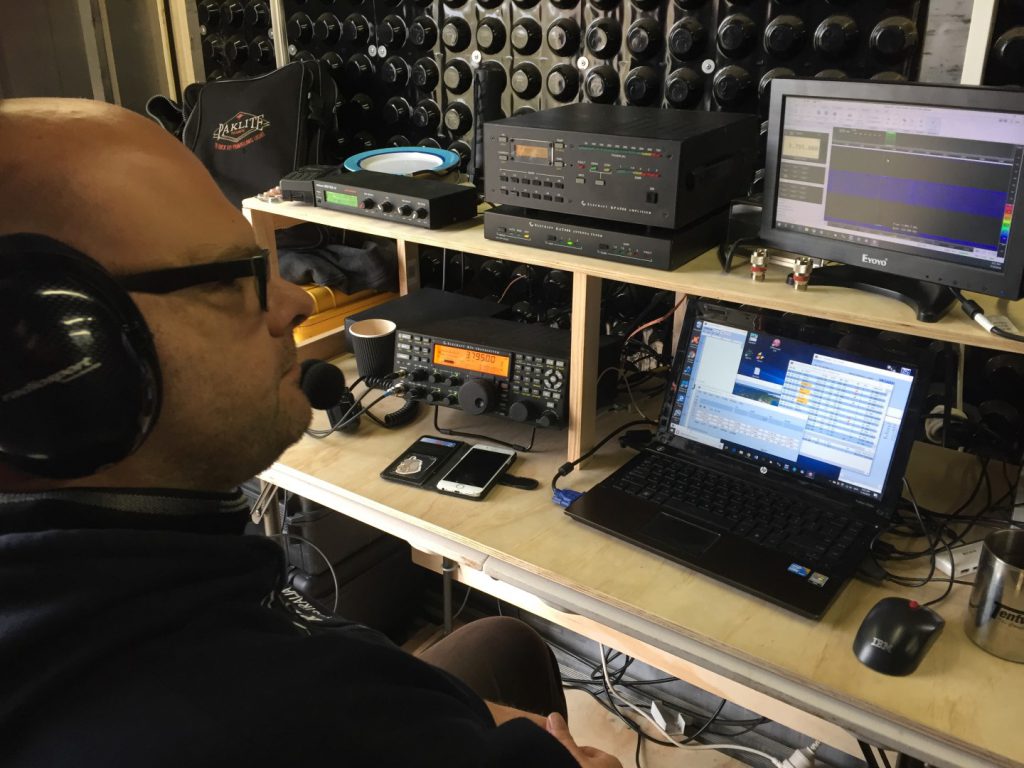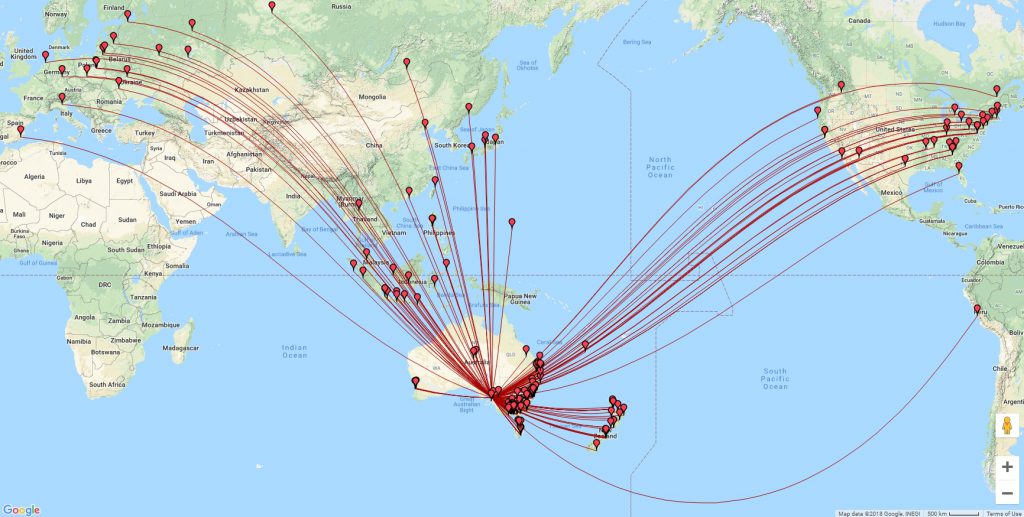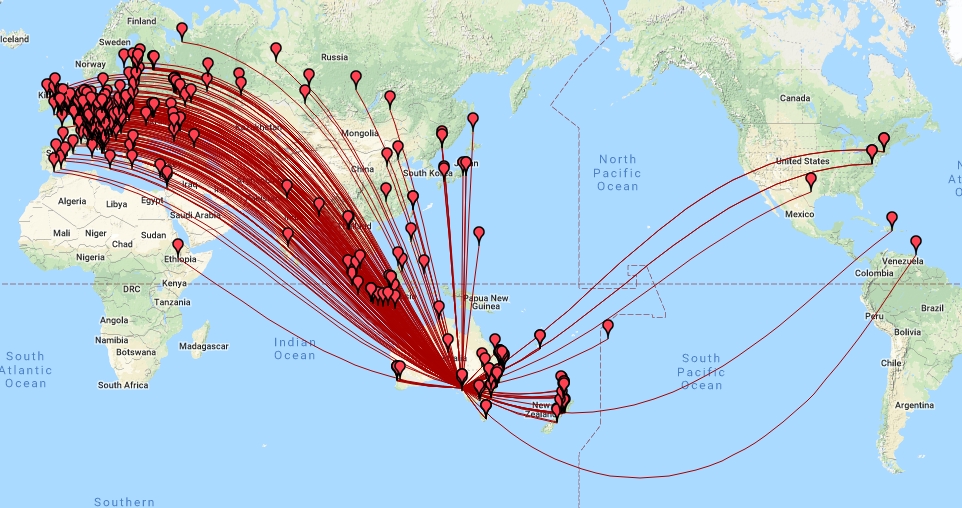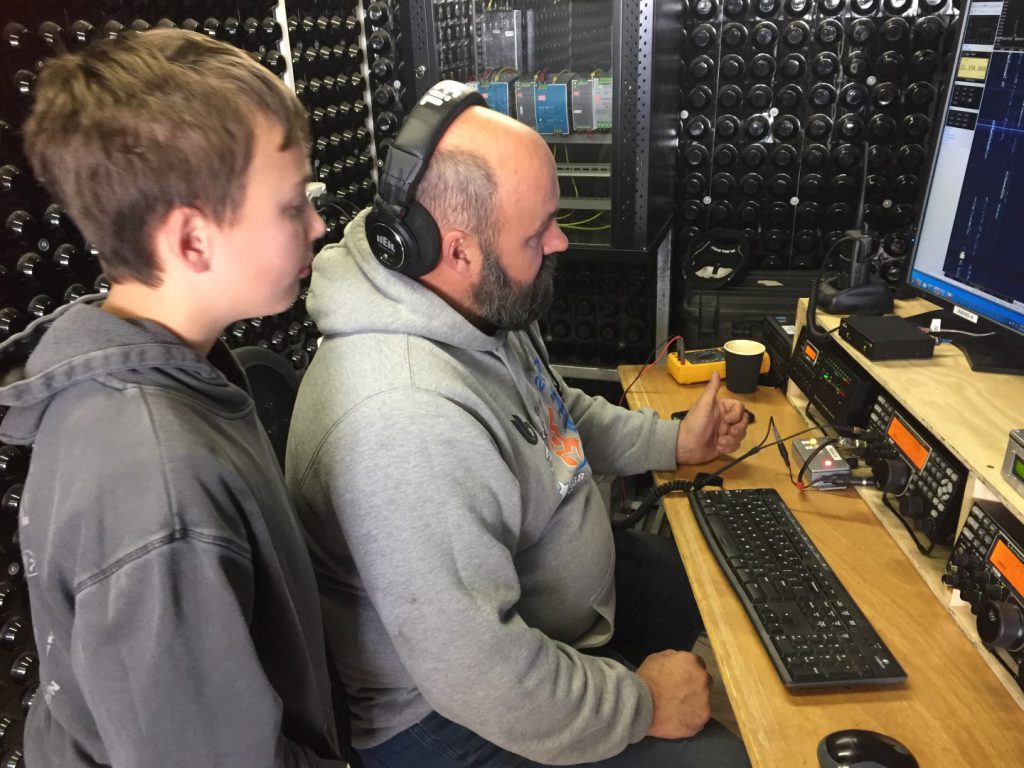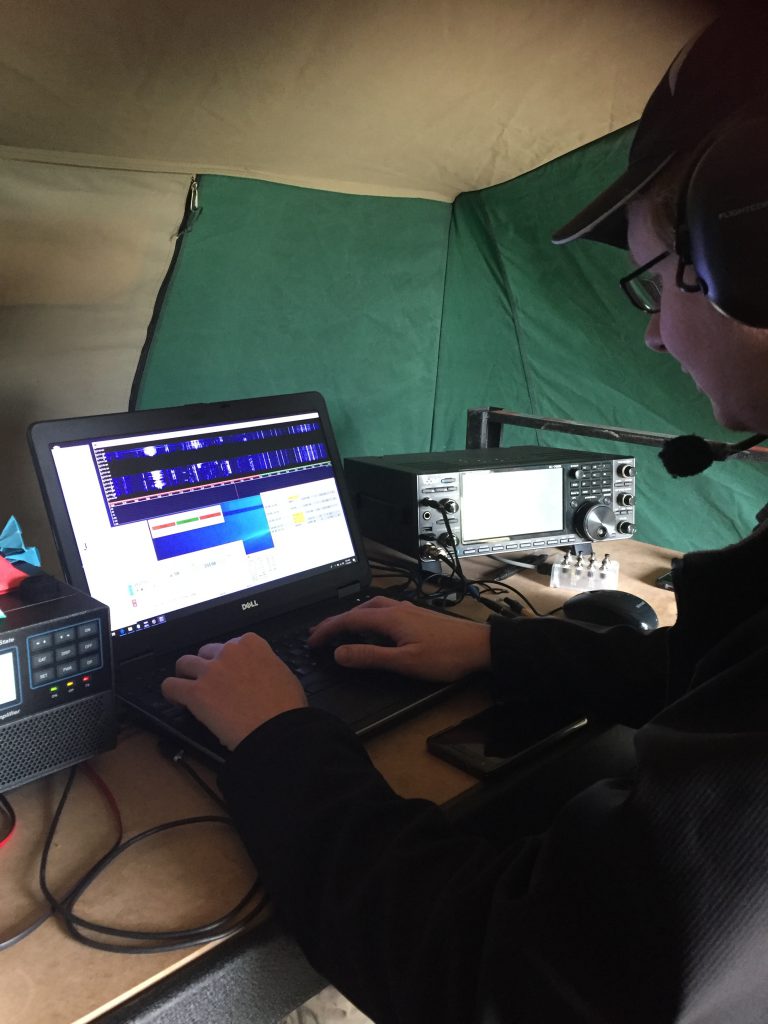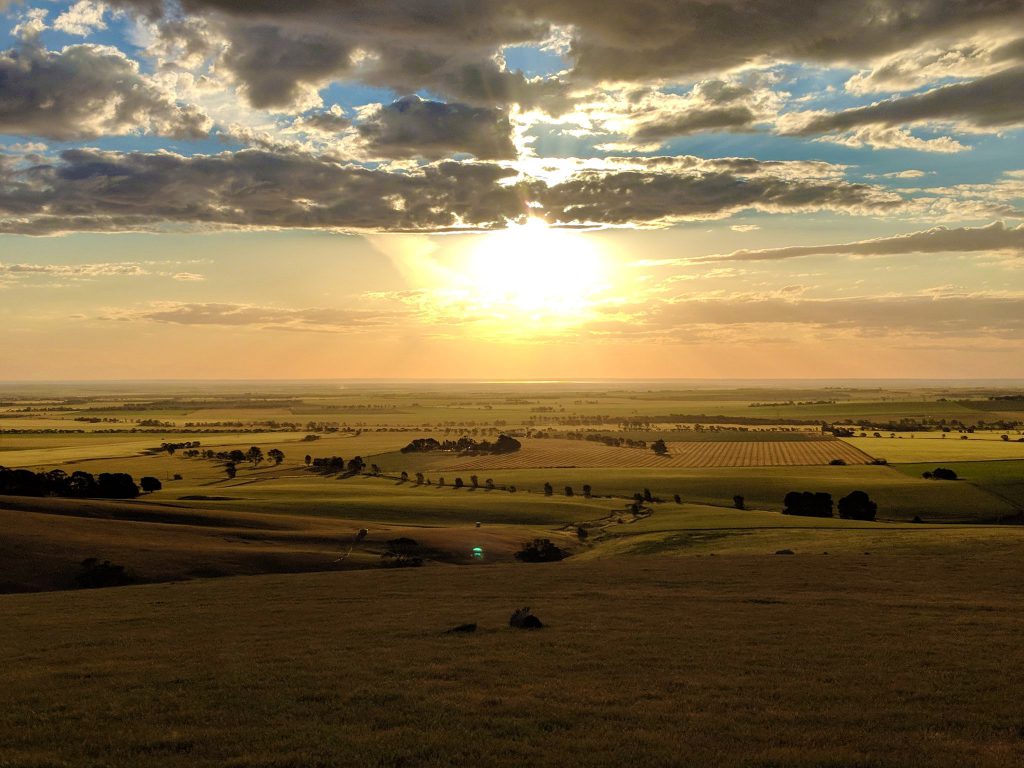Merry Christmas everyone from the Amateur Radio Experimenter’s Group. May all your DX be loud and clear in 2019!
Project Horus – Telemetry Test Flight #2 (Horus 51) Flight Report
Today’s telemetry test flight (now designated as Horus 51) was performed with (mostly) good results! This launch was an experiment to investigate solutions to the ‘Horus Binary’ payload PLL-loss-of-lock issue that has been observed on previous launches. Three payloads were launched, with variations on insulation and transmit power, all using reprogrammed Vaisala RS41 radiosonde PCBs. As a result, there was a lot of telemetry to receive on this flight!
The launch was a fairly relaxed affair, with only a small launch crew on-site. Launch occurred right on time at 11AM. It was quickly discovered that a bit too much helium was used (dodgy gas flow-rate meter!), and so the ascent rate was higher than expected resulting in the small balloon used bursting at 16.2km altitude.
As the pre-launch flight path prediction had the landing area somewhere south-west of Loxton, none of the launch crew attempted to chase this launch. Instead, Ivan (VK5HS) from the Riverland Radio Club lead a small team (Ivan, David and Peter) out from Renmark to recover the payload. As it turns out, the higher ascent rate and lower burst altitude resulted in the landing location being further away from Loxton than expected, but the Riverland boys were able to track payloads down to the ground and easily recover them not long after landing.
Many thanks to Ivan & Co for making the effort to get out and chase, it is much appreciated!
Horus 51 - Flight Statistics
| Metric | Result |
|---|---|
| Flight Designation: | Horus 51 - Telemetry Test Flight #2 |
| Launch Date: | 2018-11-25 00:30 UTC |
| Landing Date: | 2018-11-25 01:40 UTC |
| Flight Duration: | 1 Hour 10 Minutes |
| Launch Site: | -35.07568, 138.85701 |
| Landing Site: | -34.68642,139.92380 |
| Distance Traveled: | 106 km |
| Maximum Altitude: | 16,201 m |
Telemetry Statistics
Thanks to all who participated in the launch by receiving telemetry from one (or more!) of the three payloads. Statistics on how much telemetry was contributed by each receiver callsign is below:
Horus 51 - HORUSBINARY (434.640 MHz) Receiver Statistics
| Callsign | Received Packets | Percentage of Flight Received | First-Received Altitude (m) | Last-Received Altitude (m) |
|---|---|---|---|---|
| VK5FAAP | 40 | 3.7% | 4915 | 2951 |
| VK5HS | 292 | 26.9% | 12836 | 60 |
| VK5KX-3 | 1008 | 92.7% | 632 | 125 |
| VK5NEX | 335 | 30.8% | 14863 | 4601 |
| VK5QI-9 | 516 | 47.5% | 340 | 142 |
| VK5ST-4 | 893 | 82.2% | 2374 | 1301 |
| VK5WTF | 2 | 0.2% | 3959 | 3969 |
| YOUR_CALL_HERE | 478 | 44.0% | 2339 | 296 |
Horus 51 - HORUSBINARY2 (434.650 MHz) Receiver Statistics
| Callsign | Received Packets | Percentage of Flight Received | First-Received Altitude (m) | Last-Received Altitude (m) |
|---|---|---|---|---|
| VK5APR | 117 | 17.7% | 905 | 3849 |
| VK5FJGM | 267 | 40.3% | 3394 | 10661 |
| VK5KJP | 546 | 82.5% | 2054 | 1313 |
| VK5KX-2 | 641 | 96.8% | 763 | 103 |
| VK5LJG | 466 | 70.4% | 1275 | 4751 |
| VK5LJG-9 | 408 | 61.6% | 364 | 1809 |
| VK5NEX | 396 | 59.8% | 2907 | 14293 |
| VK5QI-9 | 644 | 97.3% | 378 | 103 |
| VK5ST-2 | 536 | 81.0% | 2248 | 893 |
| YOUR_CALL_HERE | 314 | 47.4% | 2981 | 14293 |
| vk5mad | 385 | 58.2% | 1464 | 14293 |
Horus 51 - 4FSKTEST (434.660 MHz) Receiver Statistics
| Callsign | Received Packets | Percentage of Flight Received | First-Received Altitude (m) | Last-Received Altitude (m) |
|---|---|---|---|---|
| VK5APR | 784 | 75.0% | 4051 | 3538 |
| VK5DSP | 116 | 11.1% | 9265 | 12591 |
| VK5KX-2 | 12 | 1.1% | 15151 | 15449 |
| VK5QI-9 | 616 | 58.9% | 340 | 144 |
| VK5ST-1 | 881 | 84.3% | 2404 | 1246 |
| VK5WTF | 808 | 77.3% | 6013 | 95 |
Please make sure you follow the configuration instructions when using the Horus Binary decoder, to avoid the ‘YOUR_CALL_HERE’ entries seen in the above tables!
Payload Testing Results
Previous Horus launches have seen the repurposed Vaisala RS41 payloads lose PLL-lock mid-flight, with the transmit frequency drifting up the 70cm band as temperature decreases. Testing on the ground indicated this may be due to the Radio IC (a Silicon Laboratories Si4032 FSK transmitter) failing with the low temperatures experienced during flight. The fact that the the RS41 sondes do not usually fail during their intended application pointed at the lower transmit power (25mW vs 50mW) used on Horus flights being a possible factor.
On previous flights the following results were seen:
- Horus 49 (Anstey 2.0) – RS41 Foam Only, 25mW – No issues Encountered.
- Telemetry Test Flight #1 – RS41 Foam Only, 25mw – Failed on Ascent at 9km altitude, recovered on descent at 1km altitude.
- Horus 50 – Stock RS41, 25mW – Failed on descent for ~6 minutes between 13km and 9km altitude.
With 2 failures and one success, it was decided that more data needed to be gathered.
On this launch, two payloads were operated at 50mW transmit power, one with a ‘stock’ enclosure (‘HORUSBINARY’) and one with only the inner foam insulation (‘HORUSBINARY2’). Using only the inner foam insulation provides a significant weight reduction, cutting the payload weight almost in half (~120g to ~60g).
A third payload (‘4FSKTEST’), using a custom-built foam enclosure was also tested, transmitting at 25mW. This had a similar overall weight (66g) to the foam-only RS41 enclosure, and re-flew the RS41 board that failed on Horus 50.
A bug in the firmware, discovered after the Horus 50 flight, was also fixed for this launch. This fix allowed gathering of measurements from a temperature sensor on the silicon die of the radio transmitter IC – unfortunately the temperature measurements captured on previous launches are invalidated as a result of this bug.
Sadly, the foam-only payload (‘HORUSBINARY2’) was observed to fail at 14.3km altitude during ascent, and recover at 4.8km on descent, failing with a radio IC temperature of 0 ˚C.
Both the stock RS41 and custom enclosure payload remained operational throughout the flight. The overall higher temperatures reported by the Stock RS41 payload may be a result of a bias in the temperature sensor, or may be a result of the better insulation – Further investigation will be performed once the payloads make their way back to Adelaide.
Curiously, the two other payloads reported radio IC temperatures lower than the failure point of the foam-only payload (0˚C), indicating that perhaps it is not the radio IC at fault, but another component on the PCB. Further investigation will be performed on RS41 PCBs using selective cooling of components, prior to the next Horus launch sometime in January 2019.
However, based on the results from this flight, it appears that the safest option for the moment is the Stock RS41 enclosure, transmitting at 50mW. As always, Horus flights use redundant telemetry transmitters, so that a failure of a single transmitter does not compromise our ability to track and recover!
Project Horus – Telemetry Test Flight #2 – Sunday 25th November 11AM CDST
UPDATE: Predictions look good, so this flight will be going ahead as planned. The launch team will not be chasing this flight – others are welcome to chase/recover the payloads if they wish.
Current planned flight parameters (for prediction purposes) are a 4m/s ascent rate, 20km burst altitude, and a ~7m/s descent rate.
On Sunday, the 25th of November, Project Horus will be performing a small balloon launch from Mt Barker High School Oval, at approximately 11AM CDST. Live flight tracking will be available on the HabHub online tracker as usual. A guide on how to decode the new Horus binary telemetry mode is available here.
This launch is another test flight of the new ‘Horus Binary’ telemetry payload, which uses a new modulation mode developed by David Rowe VK5DGR and Mark Jessop VK5QI with 6dB better performance than the usual RTTY telemetry. This telemetry mode has been flown on a few recent Project Horus flights, with mixed success – The modem has performed flawlessly, the payloads themselves not so much! These flights have flown reprogrammed Vaisala RS41 radiosondes, which while working perfectly on Bureau of Meteorology launches, have proven troublesome on Horus launches!
The last telemetry test flight suffered a loss of PLL lock on ascent, believed to be due to temperature issues, causing the payload to drift right up the 70cm band. On Horus 50, a similar fault occurred on descent, though the payload recovered within a few minutes. Further investigations confirmed a temperature issue, likely due to the lower transmit powers used on Horus flights (25mW) compared with the stock transmit power of 50mW.
This flight aims to test a few different variations on the payload flown on Horus 50, to determine if transmitting at a higher power keeps the payload alive. A few different modifications to the payload insulation will also be tested.
Currently we plan to fly 3 telemetry payloads (all on USB, +/- temperature drift):
- 434.640 MHz – Callsign ‘HORUSBINARY’ – Unmodified RS41, 50mW TX power.
- 434.650 MHz – Callsign ‘HORUSBINARY2’ – RS41 without outer plastic shell, 50mW TX power. Prioritise reception of this payload.
- 434.660 MHz – Callsign ‘4FSKTEST’ – RS41 PCB in custom enclosure, 25mW TX power.
The Horus Binary uploader script will automatically determine the payload callsign as long as you are running a recent version. Please make sure you have updated to the latest version (2018-11-15) of the Horus Binary uploader before this flight, otherwise the HORUSBINARY2 payload will not be recognised, and data for the other payloads may be corrupted. Those who were set up for Horus 50 can simply download the latest payload ID list, and place it in their horusbinary directory.
Launch will be from the usual Mt Barker High School Oval site, and launch teams will be on-site around 10:15AM, for a 11AM launch. All are welcome!
AREG 20th Anniversary – Horus 50 Flight Report
Introduction
The Amateur Radio Experimenters Group was formed in July 1998 with the aim of promoting experimentation and self learning using Amateur Radio. 20 years on, the group is a vibrant and active body that has brought together people from many walks of life, all with the common interest of experimenting and learning about radio and electronics.
One of the founding project ideas conceived by Adrian VK5ZBR, Ben VK5BB and Rod VK5UDX that drove the creation of AREG was project “Skyhook“. The aim, back then, was to fly an amateur radio payload under a weather balloon. For various reasons that goal was never achieved. However, through Project Horus (which joined AREG several years ago under the then stewardship of Terry VK5VZI), that original dream became a reality.
This flight marks Project Horus’s own milestone, having now launched 50 “heavy – 30km plus” balloons over 8 years. In that time it has become one of the most active amateur high altitude balloon projects in Australia.
To commemorate both the 50th flight and the 20th anniversary, AREG and Project Horus have decided to fly an all Amateur Radio oriented payload, promoting our core experimentation theme. The aim was to maximise involvement of the amateur radio community in the project. Here is the story of that flight.
Horus 50 – Launch Preparations
The launch crew arrived on site at Mt Barker High School by 8.30am ready to prepare the payloads and the balloon. Mark VK5QI who was flight lead was assisted by a number of AREG members including Will VK5AHV, Andrew VK5AKH, Theo VK5IR (first time Horus hunter), Kim VK5FJ, Marcus VK5WTF, Oly VK5XDX, John VK5BJE and Grant VK5GR with a number of other visitors and members who came along to watch as well. Assembly of the balloon train went to plan and, with relatively calm conditions prevailing, the filling of the balloon went smoothly too.













Liftoff
After the obligatory calls to Air Traffic Control, the team was set and the balloon took to the skies on schedule at 10.00am ACDT.
Ground Tracking & Control Stations
In support of the flight, another AREG team had set up camp approximately 50km away at Bear Rock Lookout, up above Palmer on the eastern edge of the Mt Lofty ranges. Manned by Peter VK5KX and Matthew VK5ZM, this ground station provides a vital backup telemetry link, gathering all of the signals from all of the payloads and uplinking them to the internet for the chase teams to use.
This data, when mixed with the rest of the information being received by amateurs across the state, is used by the chase teams to help fill in any packets they miss from the balloon, improving the accuracy of their landing predictions and providing a safeguard for the landing positioning data.
Meanwhile the second ground team, consisting of Grant VK5GR and Oly VK5XDX, went to the top of the ranges above Brukunga to establish VK5ARG net control for this flight’s voice repeater. We weren’t able to collocate these teams as the UHF high power up-link would have overwhelmed the tracking data down-links.
The Chase Teams
Once the balloon took off, the Mt Barker based chase teams packed up the launch site and prepared to head out. Meanwhile Darin VK5IX also started the chase, in his case also from the Bear Rock lookout. There were a few new chase teams this time which was great to see! The teams were:
- Mark VK5QI: Mark VK5QI, Will VK5AHV, Theo VK5MTM (his first Horus chase)
- Liam VK5LJG: (Just Liam, his first Horus launch, though not his first balloon chase)
- Kim VK5FJ: (Just Kim in the car)
- Marcus VK5WTF: Marcus and family
- Darin VK5IX: Darin, Glenys, Cam, Greg.
It was great to see more people getting out chasing!



Tracking and Telemetry Data Processing
There were many ways to track the flight. The usual balloon telemetry collection site was in full swing at habhub.org where all four payloads were being tracked. Amateur Radio operators and the general public could also track this flight via the Amateur Position Reporting System (APRS) on websites like aprs.fi


The other very important aspect of the flights is the data collected by the distributed listener network of amateur radio enthusiasts spread across the state. This adds a huge level of reliability and redundancy to the system that the project team really appreciates. It also gives everyone an opportunity to contribute to the project, even if only from their own radio shacks.
The interest in this flight was very high and there were many first time listeners as well as many regulars tune in and gather the telemetry off one of the RTTY or 4FSK payloads, as well as through the APRS Internet Gateway network.
In all of these a special mention goes to Andrew VK3BQ who takes the prize for the most distant telemetry decoding station at over 600km away in Melbourne.
Here are the results of how much telemetry each station was able to contribute (Note – This is per-callsign used when uploading, so some stations may have duplicate entries):
100 Baud RTTY Beacon 434.650
| Callsign | Packets Received | % of Flight Received |
|---|---|---|
| VK5NG | 850 | 76.2% |
| VK5ZRL | 845 | 75.7% |
| VK5AKK | 782 | 70.1% |
| VK5EU | 777 | 69.6% |
| VK5KX-2 | 641 | 57.4% |
| VK5APR | 427 | 38.3% |
| VK5DJ | 408 | 36.6% |
| VK5ALX | 328 | 29.4% |
| VK5KX-02 | 321 | 28.8% |
| VK5ST | 174 | 15.6% |
| VK5KX-8 | 162 | 14.5% |
| VK5KX-08 | 139 | 12.5% |
| VK5DMC | 133 | 11.9% |
| vk5st | 73 | 6.5% |
| VK5NEX | 37 | 3.3% |
| VK5KIK | 32 | 2.9% |
| VK5QI-9 | 29 | 2.6% |
| VK3BQ | 19 | 1.7% |
4FSK Binary Beacon 434.640
| Callsign | Packets Received | % of Flight Received |
|---|---|---|
| VK5QI-9 | 1693 | 88.2% |
| VK5KJP | 1666 | 86.8% |
| VK5WTF | 1239 | 64.6% |
| VK5NEX | 1193 | 62.2% |
| VK5LJG-9 | 1176 | 61.3% |
| VK5ST-9 | 1056 | 55.0% |
| VK5LJG | 889 | 46.3% |
| VK5FJ-9 | 877 | 45.7% |
| VK5TRM | 842 | 43.9% |
| VK5DSP | 627 | 32.7% |
| VK5FAAP | 324 | 16.9% |
| VK5ST | 62 | 3.2% |
A huge thank you to everyone who collected the telemetry!
This telemetry stream also allows us to analyse the path the balloon took and to confirm the flight’s vital statistics:
Not all plain sailing for the telemetry
The flight was not without it’s gremlins either. The 4FSK binary telemetry payload, which was a recovered Vaisala RS41 Radiosonde that has been re-programmed for use on 70cm, lost PLL lock at 13km on descent, and regained it at 9km altitude (about 6 minutes later). The air temperature at 13km was <-60 degrees C according to the morning BOM radiosonde launch, and -40 degrees C at 9km. The team suspects that the payload froze for a period due to it running lower power than it would for a normal sonde launch, thus not generating enough internal heat to keep from freezing. It is hoped to test this out sometime in the towards the end of the month with a small test launch carrying the same payload but running 3dB more TX power along side another RS41 PCB in a custom foam box (similar to our RTTY payload boxes).
The LoRa tele-command payload also had a fault where it lost GPS lock for the second half of the flight just after burst, likely due to it getting knocked around due to the huge dynamic shock that ripples through the payloads when the balloon bursts. This time, the GPS unit took 20 minutes to regain lock, probably because it was falling so fast (~20-60m/s). The team will be investigating some better AA battery holders, and possibly putting a big capacitor across the power input to hold up the GPS through that very dynamic part of the flight.
It goes to show, every flight is an experiment and that the team learns something new every flight!
Payloads – Slow Scan TV
The main attractions of this flight, of course, was the flying voice repeater and the first flight of the Slow Scan TV transmitter.
The live pictures broadcast over Slow Scan TV were a spectacular success, with amateurs across VK5 and VK3 able to receive them using all manner of tools and systems. The SSTV signal, running 250mW used what is known as Scottie 2 format (commonly used on HF). For the first time these images were accessible to almost everyone without any special software (which the previous high definition Wenet SSDV picture system does require). This helped generated an unprecedented interest in the flight.
We had clubs and individuals from the Riverland, South Coast, across Adelaide, and in one case from as far away as Melbourne all receiving the SSTV transmitter.
Rick Kearsley (from the South Coast ARC) received SSTV images from Horus 50 from Normanville SA with by VK5LEX/P and VK5VCR/P.
In the Riverland, Peter VK5PE and Ivan VK5HS joined in the fun.
AREG also received copies of the pictures received by Steve VK5SFA and Liam VK5LJG and know of several others in Adelaide who also successfully received the images live from the balloon (including our primary ground station at VK5KX/P, who received one only 500ft off the ground).
The best effort award however must go to Alan, VK3DXE who from the eastern side of Melbourne was able to receive the SSTV transmitter at apogee using his EME station. Not a bad effort for a 250mW FM transmission on 145.1MHz at over 630km range.
This was the array Alan was using.
From the balloon’s perspective we also kept a copy of the images on the SD card. This is what they looked like prior to broadcast.
Payloads – Voice Repeater
The other amateur radio related payload flown was a cross band voice repeater. This machine had a receiver on 438.900MHz (with a 123Hz CTCSS tone) and a transmitter on 147.500MHz running approximately 1 Watt. This was a return to the original voice repeater flown back on Horus 9 and 23 after the problems with narrow band FM on the more recent repeater flights.
During the flight, it became clear that this old machine still had some problems. Unfortunately the faults didn’t reveal themselves until after lift off. The repeater was de-sensitising its own receiver (a suspected 3rd harmonic problem), and with the rather windy flight aloft, there was also a lot of swinging around of the antennas (TV Ribbon J-Pole antennas) which made contact very difficult to achieve through the balloon. None the less, 32 contacts were logged through the repeater by stations from as far as Millicent in the SE, Renmark in the NE and Whyalla / Port Pirie in the Iron Triangle to the NW.
The following is the full log of the contacts made through the balloon with net control.
VK5ARG Log
| Call | QSO_Begin_Date | QSO_Begin_Time | Freq | Mode | QTH |
|---|---|---|---|---|---|
| VK5QI | 2018-11-03 | 2338Z | 147.5 | FM | Glenelg |
| VK5GR | 2018-11-03 | 2338Z | 147.5 | FM | |
| VK5PET | 2018-11-03 | 2339Z | 147.5 | FM | Strathalbyn |
| VK5XB | 2018-11-03 | 2341Z | 147.5 | FM | |
| VK5IR | 2018-11-03 | 2341Z | 147.5 | FM | Mansfield Park |
| VK5BJE | 2018-11-03 | 2341Z | 147.5 | FM | Maurice |
| VK5WTF | 2018-11-03 | 2344Z | 147.5 | FM | Munno Para |
| VK5APR | 2018-11-03 | 2345Z | 147.5 | FM | Flinders Park |
| VK5KX | 2018-11-03 | 2345Z | 147.5 | FM | Salisbury Park |
| VK5ZM/P | 2018-11-03 | 2346Z | 147.5 | FM | |
| VK5ZAR | 2018-11-03 | 2347Z | 147.5 | FM | Broadview |
| VK5BB | 2018-11-03 | 2351Z | 147.5 | FM | Redwood Park |
| VK5IX | 2018-11-03 | 2352Z | 147.5 | FM | Freeling |
| VK5YX | 2018-11-03 | 2356Z | 147.5 | FM | Hallett Cove |
| VK5PE | 2018-11-04 | 0013Z | 147.5 | FM | Renmark |
| VK5DJ | 2018-11-04 | 0014Z | 147.5 | FM | Millicent |
| VK5HS | 2018-11-04 | 0015Z | 147.5 | FM | Renmark |
| VK5ST | 2018-11-04 | 0019Z | 147.5 | FM | Angaston |
| VK5ZRK | 2018-11-04 | 0020Z | 147.5 | FM | Ridgehaven |
| VK5DMC | 2018-11-04 | 0023Z | 147.5 | FM | Port Pirie |
| VK5ALX | 2018-11-04 | 0024Z | 147.5 | FM | Whyalla Playford |
| VK5XB | 2018-11-04 | 0029Z | 147.5 | FM | |
| VK5SFA | 2018-11-04 | 0053Z | 147.5 | FM | Woodforde |
| VK5AKK | 2018-11-04 | 0100Z | 147.5 | FM | Crafers |
| VK5WU | 2018-11-04 | 0108Z | 147.5 | FM | Hope Valley |
| VK5TEC | 2018-11-04 | 0115Z | 147.5 | FM | |
| VK5HS | 2018-11-04 | 0118Z | 147.5 | FM | Renmark |
| VK5CV/MOB | 2018-11-04 | 0120Z | 147.5 | FM | |
| VK5EU | 2018-11-04 | 0122Z | 147.5 | FM | Hilton |
| VK5KBJ | 2018-11-04 | 0126Z | 147.5 | FM | Aldinga Beach |
| VK5ZM/P | 2018-11-04 | 0128Z | 147.5 | FM | |
| VK5JP | 2018-11-04 | 0142Z | 147.5 | FM | North Haven |
Payload Recovery
As sure as the laws of gravity go, what goes up must come down! The balloon climbed to over 35km before bursting and returning to earth. The following are the vital statistics of this flight:
| Metric | Result |
|---|---|
| Flight Designation: | Horus 50 - AREG 20th Birthday |
| Launch Date: | 2018-10-03 23:14 UTC |
| Landing Date: | 2018-10-04 01:59 UTC |
| Flight Duration: | 2 Hours 45 Minutes |
| Launch Site: | -35.07568, 138.85701 |
| Landing Site: | -35.184284, 139.755216 |
| Distance Traveled: | 82.6 km |
| Maximum Altitude: | 35,861 m |
The chase teams themselves were in an excellent position to recover the payloads and indeed watched them land from about 1km away. After contacting the land owner (to seek permission to enter and collect them), all of the payloads were successfully recovered, ready to fly another day.
Conclusion
At the end of the day the team was very happy with the results. What was even better were the number of people who participated in the event, either on site or from home with tracking, SSTV, FM voice, or just tuning in on social media and following along via the Internet. It truly represents the aims of AREG in promoting experimentation in Amateur Radio to see all of the people who joined in. To each and everyone of you, thank you for your participating!
To the teams that built and flew the balloon, a special thank you to you as well. May there be many more!
73 de Grant VK5GR
Horus 50 Frequency & Tracking Data
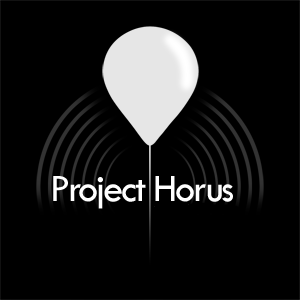 If you wish to take part in either communicating with / via Horus 50 or are simply curious as to what is going on the following summary should help. Liftoff is planned for 10AM ACDT (2330z) Sunday morning.
If you wish to take part in either communicating with / via Horus 50 or are simply curious as to what is going on the following summary should help. Liftoff is planned for 10AM ACDT (2330z) Sunday morning.
 Where is the Balloon?
Where is the Balloon?
You can track the balloon via the HabHub Website. Follow this link
What Frequencies can I listen on / talk through?
- 147.500MHz Downlink / 438.900MHz Uplink (with 123Hz CTCSS) Repeater
- 145.100MHz Slow Scan TV Downlink (using Scottie 2 format)
- 145.175MHz APRS Tracking Beacon
- 434.650MHz 100baud RTTY Telemetry
- 434.640MHz 4FSK Binary Telemetry (uses the latest FreeDV software to decode)
When using the FM voice repeater be aware that it will be under controlled net conditions and that the chase teams have priority at all times to use the repeater to coordinate recovery. Net control will be VK5ARG – call in to VK5ARG and listen to instructions please so that everyone can get a turn.
In particular, remember to turn your CTCSS tone on your 70cm transmitter and set it to 123Hz. Forgetting to do so will jam the repeater for every other user.
Where can I get up to date information?
If you have a twitter account, watch Hashtag #horus50 . Updates will also be posted on the AREG’s Facebook page as events unfold.
[custom-twitter-feeds hashtag=”#horus50″]
Further details about the telemetry etc can be found on the main flight information bulletin available from (here).
If i want to see the launch where can I go?
We are launching from the southern oval at Mt Barker High School. The team should be on site from 9am.
Good luck and enjoy this celebration of the 50th flight of Project Horus in the 20th year of the Amateur Radio Experimenter’s Group.
UPDATE: Horus 50 High Altitude Balloon Flight this SUNDAY!
Preparations continue for the Horus 50 high altitude balloon flight celebrating the 20th Anniversary of AREG. This radio experimenters flight is planned for launch this Sunday, the 4th of November at 10am CDST (2330Z). The latest flight path prediction is shown below. Full details of the flight can be found (here)
UPDATE: 3rd November 2018 – Predictions still looking good!
 Tracking will be available via habhub.org
Tracking will be available via habhub.org
As a quick reference, the flight will have the following transmitters:
- 147.500MHz Downlink / 438.900MHz Uplink (with 123Hz CTCSS) Repeater
- 145.100MHz Slow Scan TV Downlink
- 145.175MHz APRS Tracking Beacon
- 434.650MHz 100baud RTTY Telemetry
- 434.640MHz 4FSK Binary Telemetry (uses the latest FreeDV software to decode)
Stay tuned for more details and refer to the main news story (here) for information on how you can participate in this event!
Come and Try Foxhunting Event – Saturday November 10th @ 1.00pm
AREG members are looking to rekindle interest in Fox Hunting and Radio Direction finding in Adelaide. To get the ball rolling, following the special fox hunting presentation on Friday 9th November at the clubrooms by Bryan VK3YNG, the club is holding a come and try fox hunting / radio direction finding event in the SE Parklands on Saturday 10th November from 1.00pm till 3.00pm.
The come and try day will allow those without gear to come and see how to get started and to try their hands at some pedestrian direction finding using equipment such as Bryan’s sniffer receivers.
Visitors are most welcome at both events. If you have ever been curious or just want to come for a day in the park on Saturday then drop on by – we would love to see you and introduce you to the fascinating world of radio direction finding!
The event will be staged in the SE Parklands, off Beaumont Rd (enter from the Greenhill Rd end). Directions can be found from the map below or by calling on the Summertown 70cm repeater VK5RSB on 439.900MHz (91.5Hz CTCSS).
Oceania DX SSB Contest 2018 – AREG Portable
Once again the Amateur Radio Experimenters Group entered the Oceania DX Contest from a portable station established on the ranges ~100km north of Adelaide. The group established a DX capable HF station with verticals on 160/80/40m and beams+verticals on 20/15/10m at full legal power (400W) with the explicit aims of:
- experimenting with antennas and antenna systems
- training operators in contesting
- experimenting with filtering and transceiver configurations
The planning for the event starts several months out with a planning night held back in the club rooms. Each band is assigned a captain who leads the group responsible for that particular station. All up about 20 members are involved in some way in the design, construction and operation of the multi-multi portable station.
Low Band Station Development
Each year a new part of the system is constructed. This years major advancements occurred firstly with the low band station lead by Steve VK5SFA and Grant VK5GR (160/80m). New vertical antennas were designed and tested, with the 80m antenna being trialed during the Trans Tasman Low Band Challenge contest in July. 80m was based on a folded 1/4 wave vertical monopole with elevated radials derived from a modified crankIR vertical.
The 160m antenna was based on a capacity hat loaded 17m vertical (derived from designs by DJ0IP). After several working bees Steve gathered a group together and staged a test and tune day in a local park in Adelaide a few weeks before the event.
The addition of these antennas this year replaced the dipoles used last year. The intention from moving to verticals was to lower the angle of radiation, thus (hopefully) improving our chances for DX. The low band station was then ready for action.
High Band Station Upgrades
On the high band station Matt VK5ZM was scrambling to complete the design of the antenna switching network for the SO2R (Single Operator 2 Radio) 20/15/10m station. This system is unique in that it manages the antenna switching between both bands and radios to enable one operator to call CQ on two bands at the same time. Last year was the first time “the beast” as it is known was tried. This year the rest of the automation needed to be completed with the antenna selection and switching boards. Matt worked tirelessly to complete the system integration in time.
After all the preparations we were ready for the contest weekend.
Day 1 – Friday – Construction begins
With a virgin site to occupy, members started out early from Adelaide on the Friday. The first antenna to make it into the air was the 80m vertical, ready by about 11am. Oly VK5XDX, Steve VK5SFA, Grant VK5GR and Mark VK5QI all helped getting the first array into the air. Team 2 then arrived and started on the 40m antennas while Team 1 started on 160m. Lead by Andy VK5AKH, the 40m team included Peter VK5KX, Gerard VK5ZQV, Paul VK5PH and Scott VK5TST (who also set up the camp kitchen).
The 40m team got cracking and in short order got their first antenna in the air as well, which was an inverted V intended for domestic contacts (much higher angle of radiation).
While the inverted V went up work progressed preparing to raise the 160m antenna. This was the first trial of the weekend. As the antenna was raised, the top 7m section which was made from a 9m squid pole failed. The top hat wires were proving to be quite heavy and hard to control as the tower was raised using a temporary derrick.
Fortunately the squid pole wasn’t damaged and we were able to lower the array and reset for a second try. Unfortunately Murphy had invaded the site and the next 3 attempts didn’t go any better, with the 4th try seeing the demise of the squid pole as it shattered. The moral of the story was that Squid poles are just not sturdy enough for this application,and the capacity hat wires should be made of lighter materials.
Facing the prospect of no 160m antenna at all, the team hit upon a plan to put up a 12m version of the antenna, and compensate with the antenna matching unit. Finally on the 5th attempt with the light failing the antenna and its 700m worth of radials came into resonance with a good VSWR. Time would tell whether it would radiate well the next night as the contest started.
Team 2 on 40m meanwhile was having more luck. Their second antenna was an elevated feed 40m quarter-wave vertical with elevated radials. After realizing a couple of components of the feed system had been left behind, some bush mechanics were performed and the antenna climbed into the sky.
The WIFI coax relay switch was installed and the LMR400 feeders for both 160 and 40m were run nearly 200m back to the operating hut.
Finally, the 40m station was setup and the team began test contacts during Friday night using a ICOM IC7610 and SPE 1.3KFA linear followed by a Low Band Systems 1500W filter.
Compared the last year we were back on schedule with all antennas in the air for 160-40m by the end of day 1.
Day 2 – Saturday – Construction and Contest Start
Saturday saw more of the construction crew arrive and work start on the high band station as well as loading all of the radios into the operating cabin. Matt VK5ZM arrived with his done Daniel VK5FDNA and then the team was joined by Darin VK5IX and Kim VK5FJ who bolstered the crew building the high band station. By now there are people everywhere (so if I have missed someone please let me know so I can add you). By lunchtime the last of the antennas were deployed with the verticals setup for 21 and 28MHz and the tri-band spider beam was in the air for 20/15/10m. The antenna combining and switching network was also established.
To support the station, a tent city was assembled providing sleeping quarters for the radio crew. Site logistics were managed and the kitchen staffed by Scott VK5TST. A key aspect of the event is to keep the team well caffeinated and fed. Assisted by Sharon VK5FSAW who shopped and planned the menu, Scott kept everyone plied with everything their stomachs desired.
So far this year the team had been blessed with excellent weather as well. Unlike last year when the station was built with 30-40knot winds howling over the hills, it was mostly calm this year making construction much easier.
Finally, as the start time approached, the finishing touches were put on the station and facilities. 40/80 and 160m opened up on queue at 0800z and the contest began.
Murphy however decided to show his hand again, this time around the high band station. PTT switching issues were uncovered at the last minute and unfortunately the TR switching was damaged in one of the SO2R station amplifiers. Matt VK5ZM struggled on but in the end the last minute rush to complete the development of the antenna switching network the preceding week meant that there just wasn’t enough time to debug the rest of the SO2R station. About 30 minutes into the contest the sad decision was made to demote it to a single radio. This delayed activating the 20m station by about an hour. None the less, once all was ready away we went with 3 active operating positions across 4 bands (with manual switching on 80/160m).
Night fell, dinner was served and everyone settled into the routine of calling CQ. Oly, who was a new contester in the team quickly proved he was a machine on both the 160/80 and the 20m station while a steady crew manned 40m.
Through the night the score slowly built with the effort invested in the low band station in particular raking in points, although not so many multipliers. 20m proved as always to be the multiplier gathering band. Even so, the following map shows the reach achieved by the 160/80m station:
40m meanwhile was powering along as well with lots of traffic from Europe as well as a reasonable amount from North America. Nighttime on 40m was hard going however when the band filled with a huge number of YB contest stations. This should have been a blessing, but obviously their noise floor was such that they couldn’t hear our 400W despite our 5×9 copy of them.
As the night wore on, 80m was hit by another curse. Two of the dreaded northern radar stations appeared, one taking out 3720-3780 and another taking 3790-3850. For a while we had a 10kHz gap in which to eek out contacts before one of the radars moved down to fill it – thus putting an end to any aspirations of working DX on 80m.
20m meanwhile powered on into the night before giving up on Short Path Europe around midnight. At this point, we entered the “long dark teatime of the soul” in contesting – the graveyard shift where we called incessantly but made little progress. Little did we know that with sunrise things were about to get much worst.
Day 3 – Sunday Morning
The team had been watching the solar forecasts for the preceding couple of days and had reached the point where we were dreading what would happen on Sunday. Sure enough, just when we didn’t want them to, the predictions came true with a geomagnetic storm starting on the daylight side of the planet over the Pacific. We watched as the T index dived lower and lower, creeping across the equator and rendering our North American and later our Asian and European (LP) paths useless.
Even contact with Japan was problematic. Then the real rub set in. We would call JA stations we could hear, but they would answer with us saying “Sorry no contact JA Only!”. There was a JA domestic contest on and they did not want to give us a QSO! We tried repeatedly Sunday morning on 20m and occasionally on 15m but to no avail. Robbed of our one great hope for prefix multipliers in JA, plus no North American short path (and only a fleeting 20 minute long path NA opening) our score progressed along at a glacial pace.
In the face of adversity we soldiered on and took the time to train some new operators. 11 Year old Daniel VK5FDNA, who had only just qualified for his foundation license a few weeks before, was coached through a couple of contacts with his dad Matt VK5ZM.
Meanwhile we also had Gerard VK5ZQV get some practice in as well. It was clear we weren’t going to set any records this year so we decided to use the time we had well, sowing the seeds for next year.
We also had some visitors to the site during Sunday with Ben VK5BB and Olga VK5FOLG making the trip up for a look as did Paul VK5PH. Ady (newly licensed as VK5FADE) brought his family along to see what it was that we had been talking about at the club over the past couple of months. It was great to see some new faces looking to discover what the contest station and scene was all about.
Later in the afternoon 40m came back to life and we were able to put a few more EU and South American stations in the log.
Finally as the contest drew to a close, it seemed on 20m at least as though we ran out of stations to work. The signals we could hear were all in the log. We had even stooped so low as to beg a contact from a couple of VK nets. In the end we could only muster less than half our score from 2017. Given the amount of effort that went in to building the station, a bit of a disappointing result, however a result none the less.
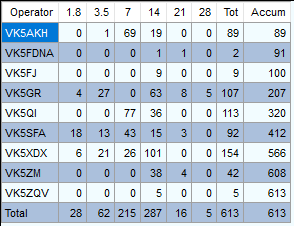
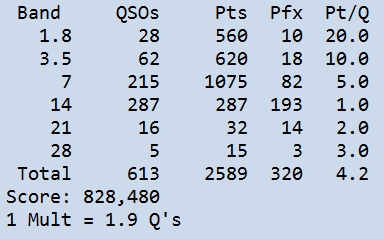 So, as the sun set over the site, the station wound down. The team then retired to the meals area for a baked potato feast with all the trimmings.
So, as the sun set over the site, the station wound down. The team then retired to the meals area for a baked potato feast with all the trimmings.
After dinner quite a few headed for home and a comfortable bed while the die hards remained on site to work some more DX.
Day 4 – Tear Down
The next morning fresh troops arrived from Adelaide, and the process of packing up began. Our luck with the weather finally failed us with winds approaching 40 knots ripping over the site. None the less, timed between gusts, all the antennas were safely lowered to the ground and carefully packed back into their cases and bags for transport home.
What had taken 2 days to build was secured on trailers and ready to roll in under 5 hours. The remains of the team then headed to Kapunda Bakery for lunch before dispersing back to our home QTHs ready to think about 2019.
Thank You!
The contest band captains couldn’t have done it without all of the help received from members of the club. So in no particular order, we would like to thank the following:
VK5TST, VK5XDX, VK5SFA, VK5GR, VK5AKH, VK5QI, VK5FJ, VK5ZM, VK5FDNA, VK5KX, VK5ZQV, VK5PH, VK5IX, VK5FSAW who all helped design, construct, provide logistics in terms of food and sanitation, man the station on air and then tear down VK5ARG for 2018! (and apologies if I have missed someone). It is a huge team effort each year and this year was no exception.



